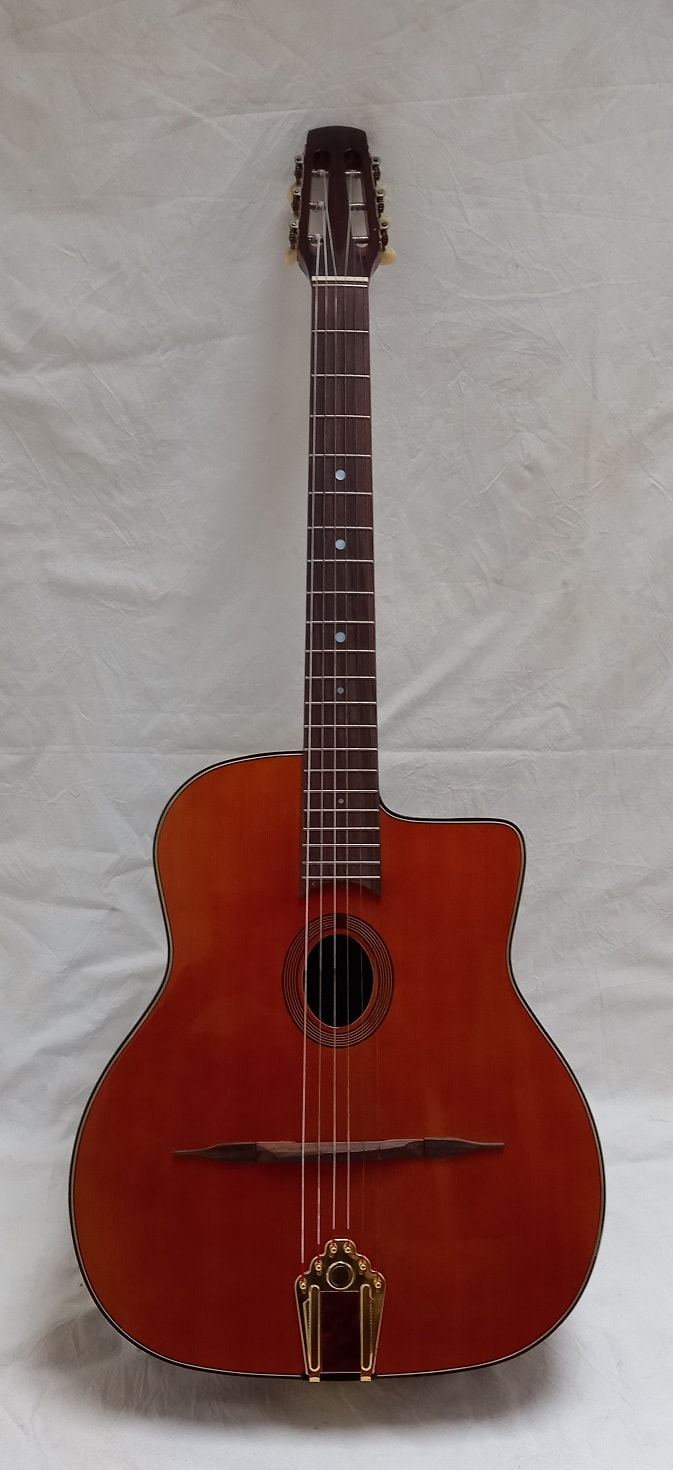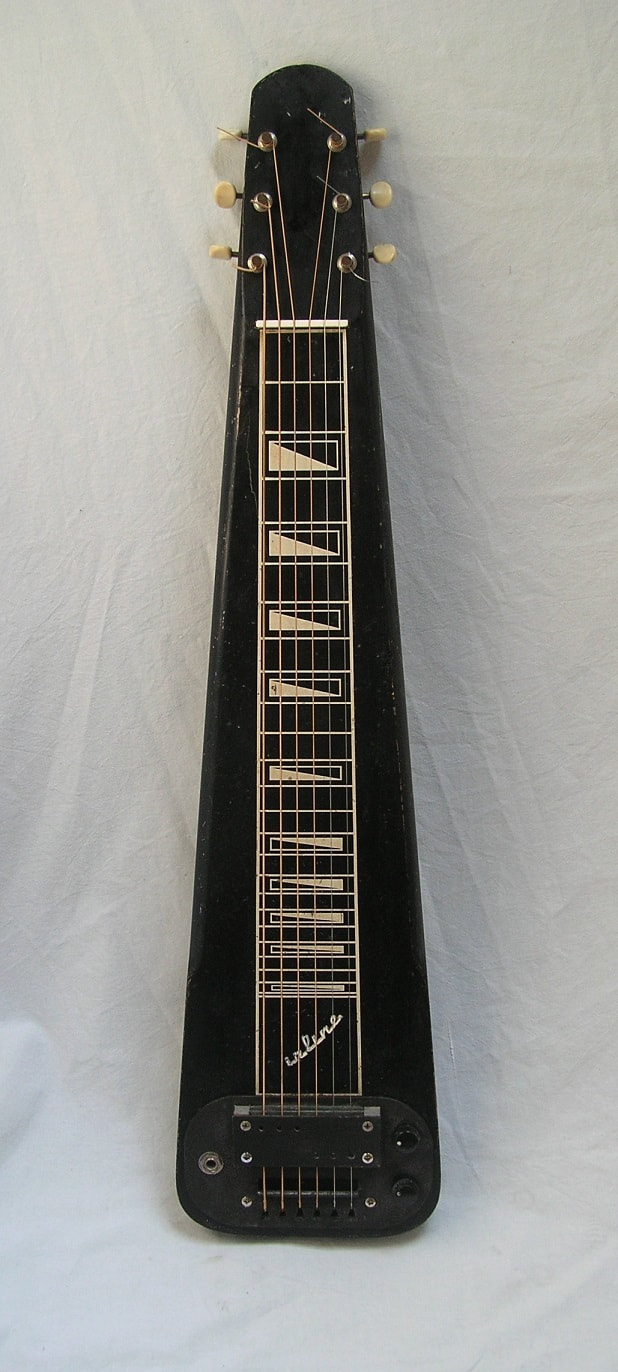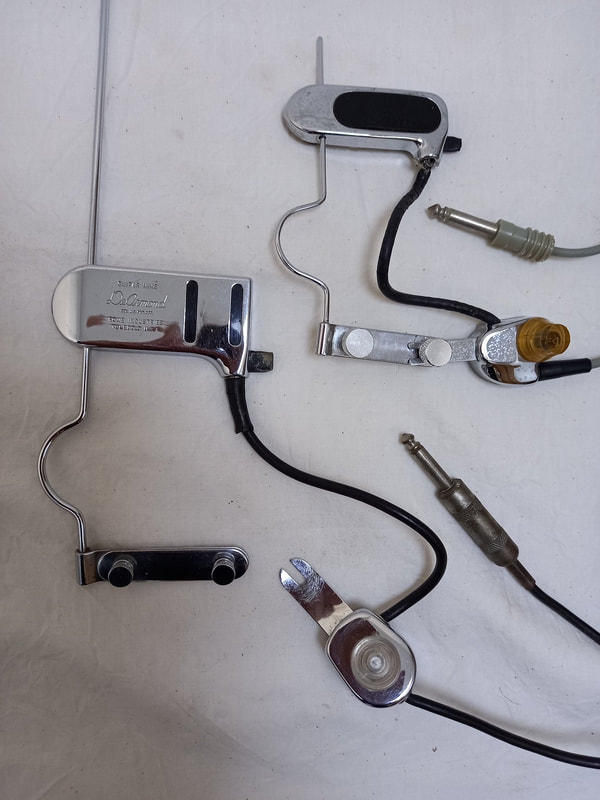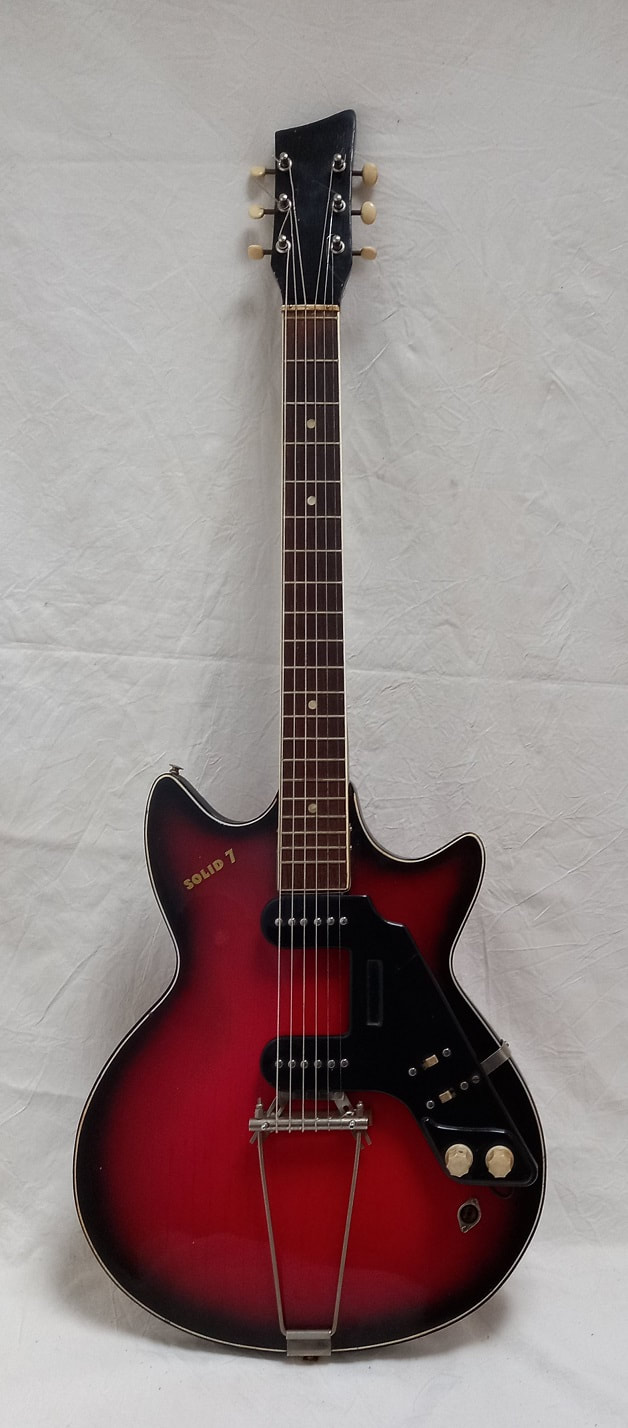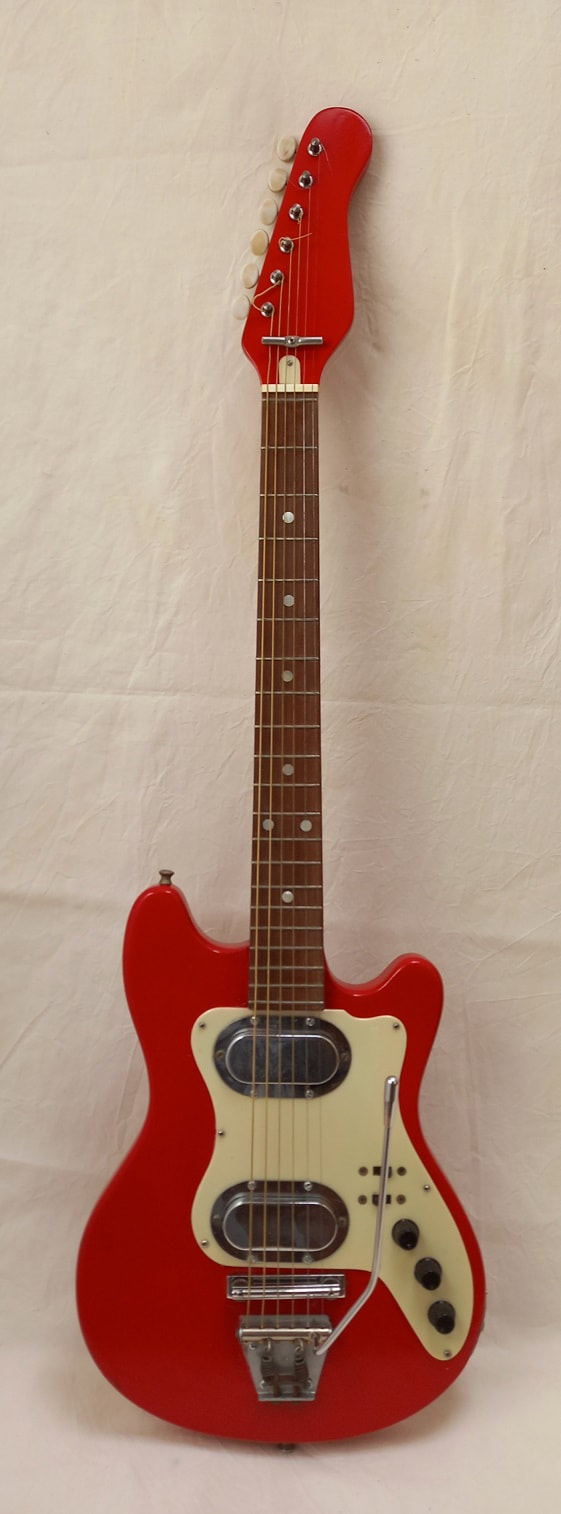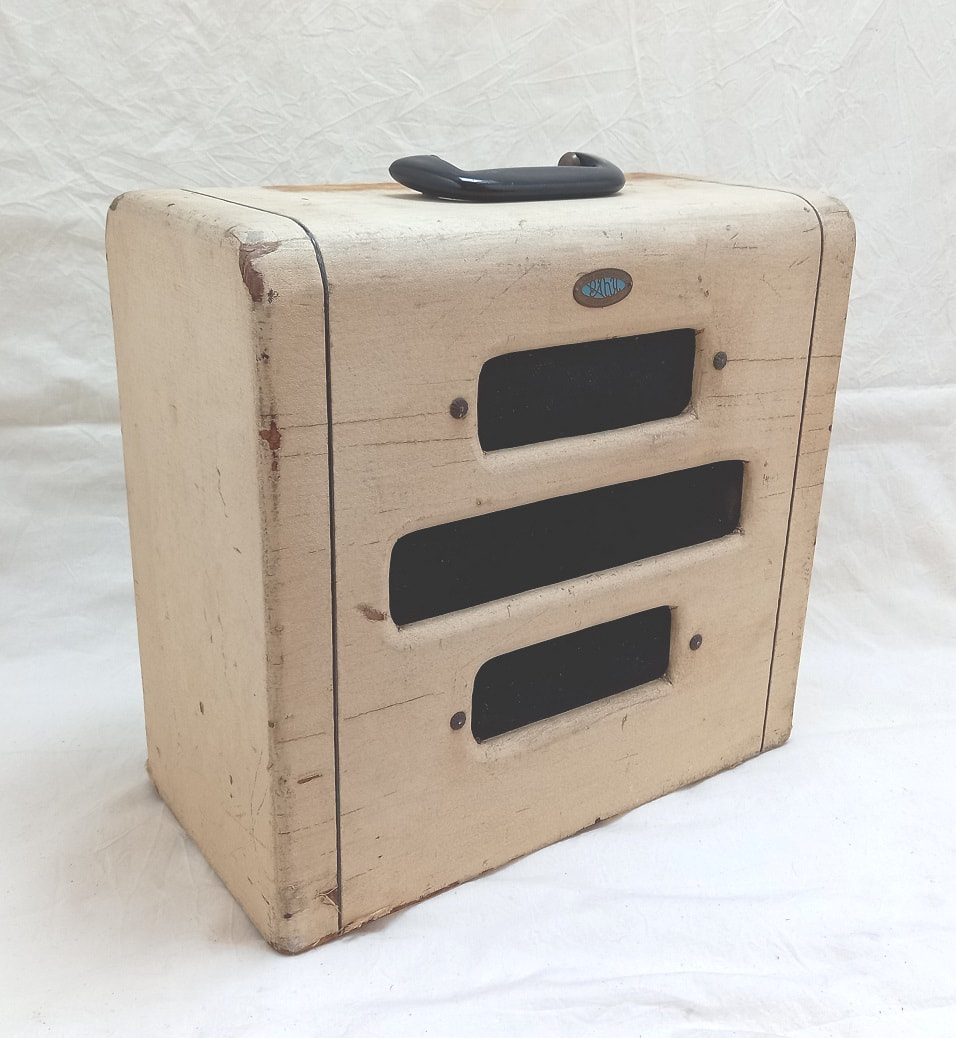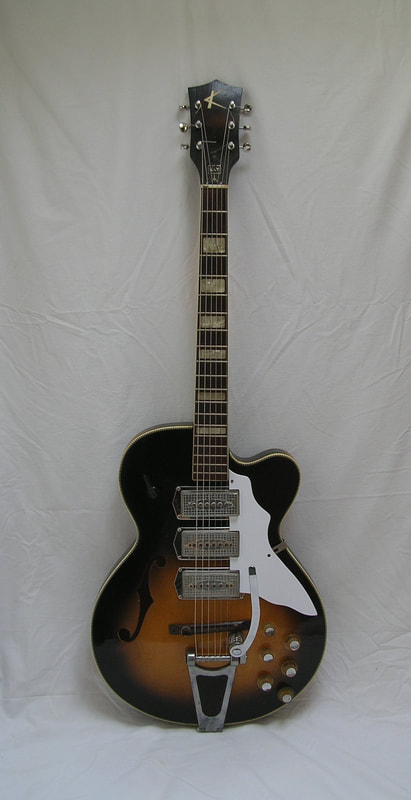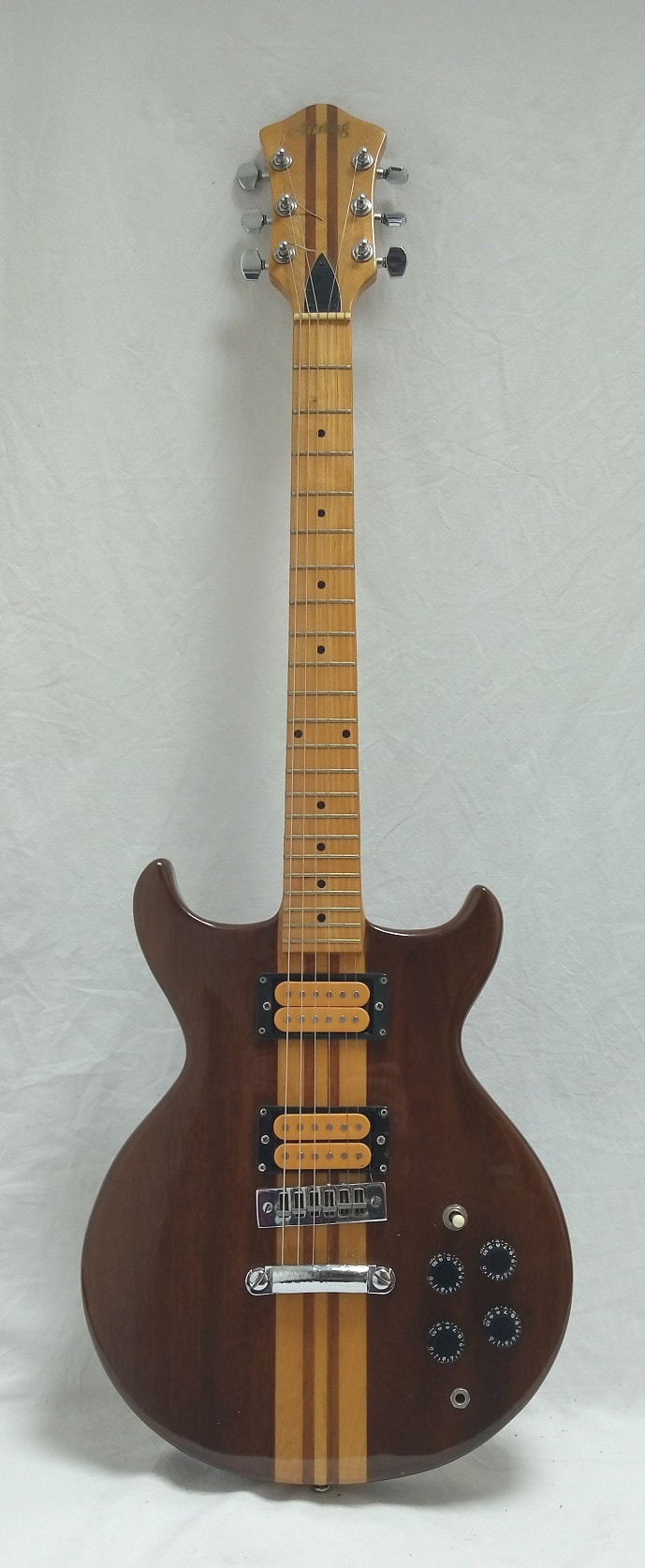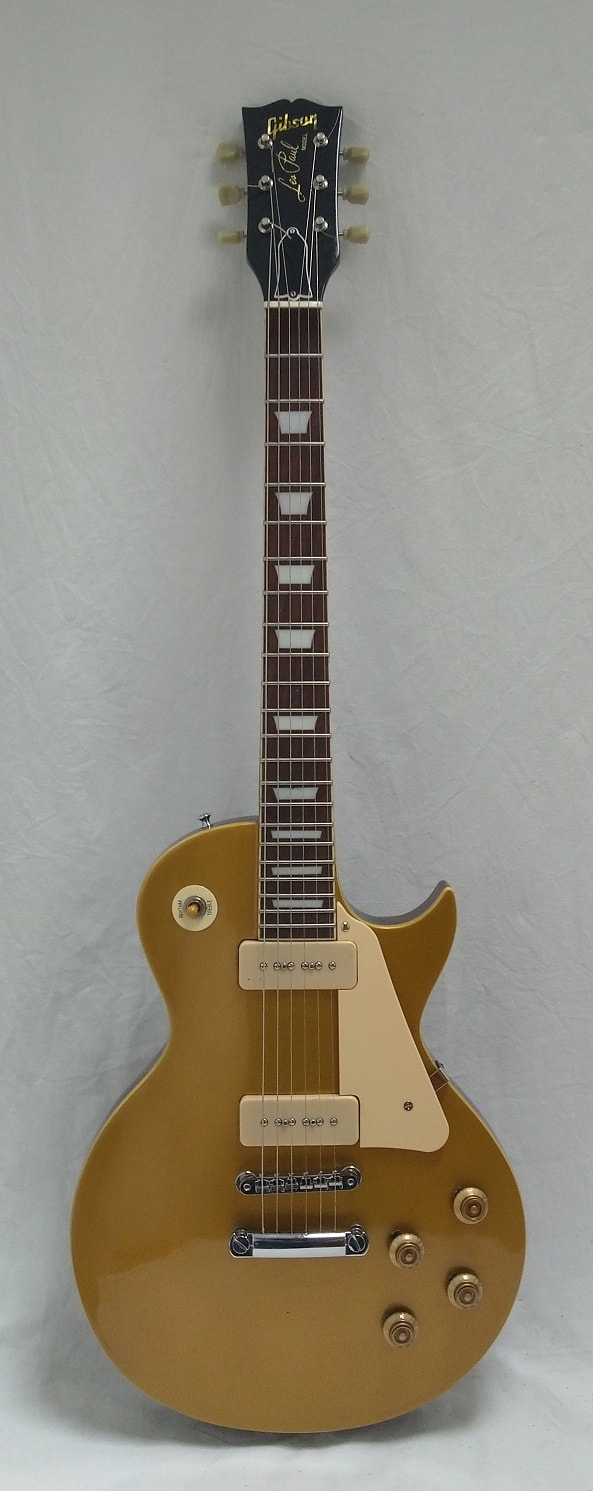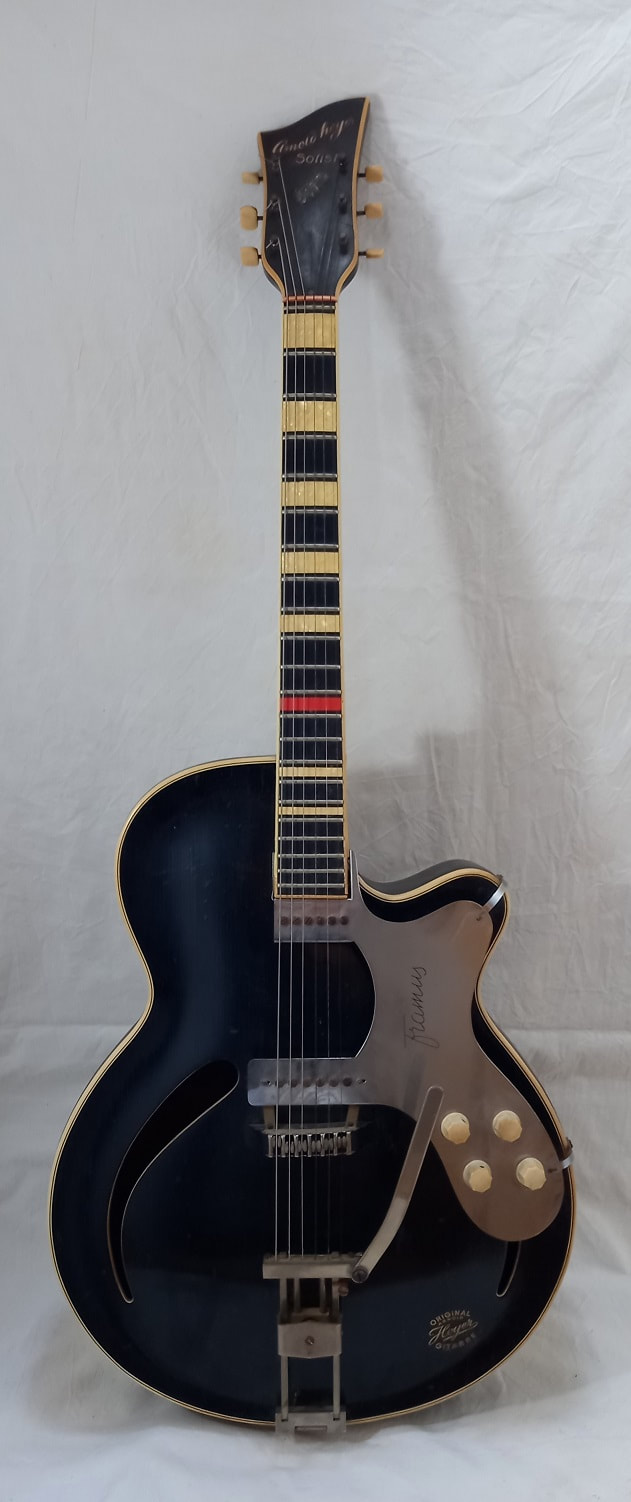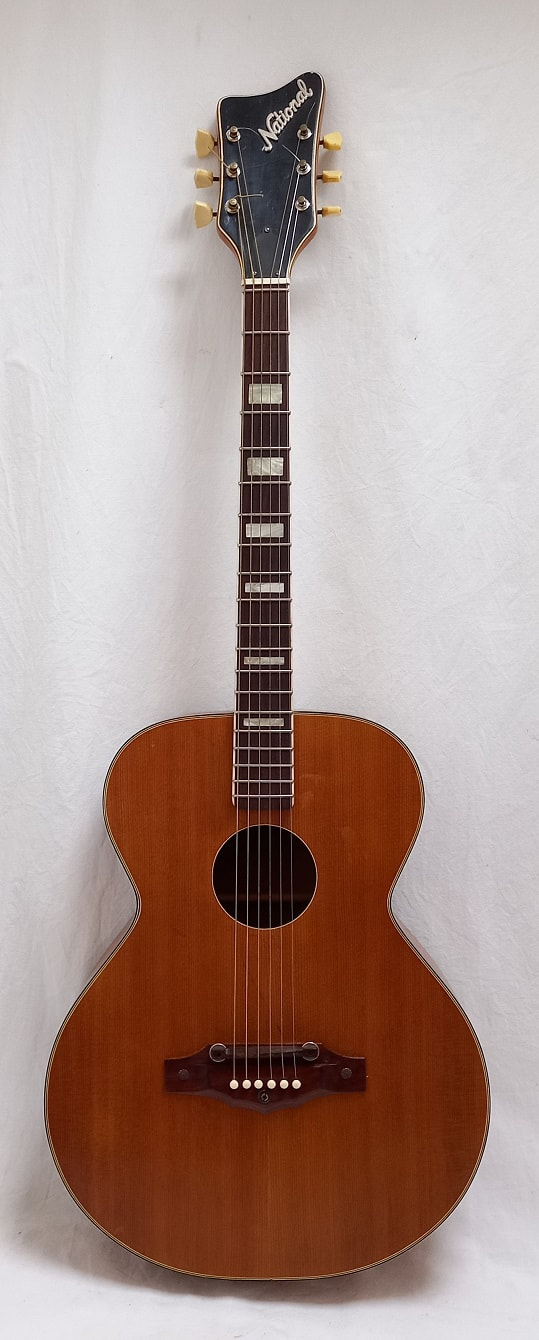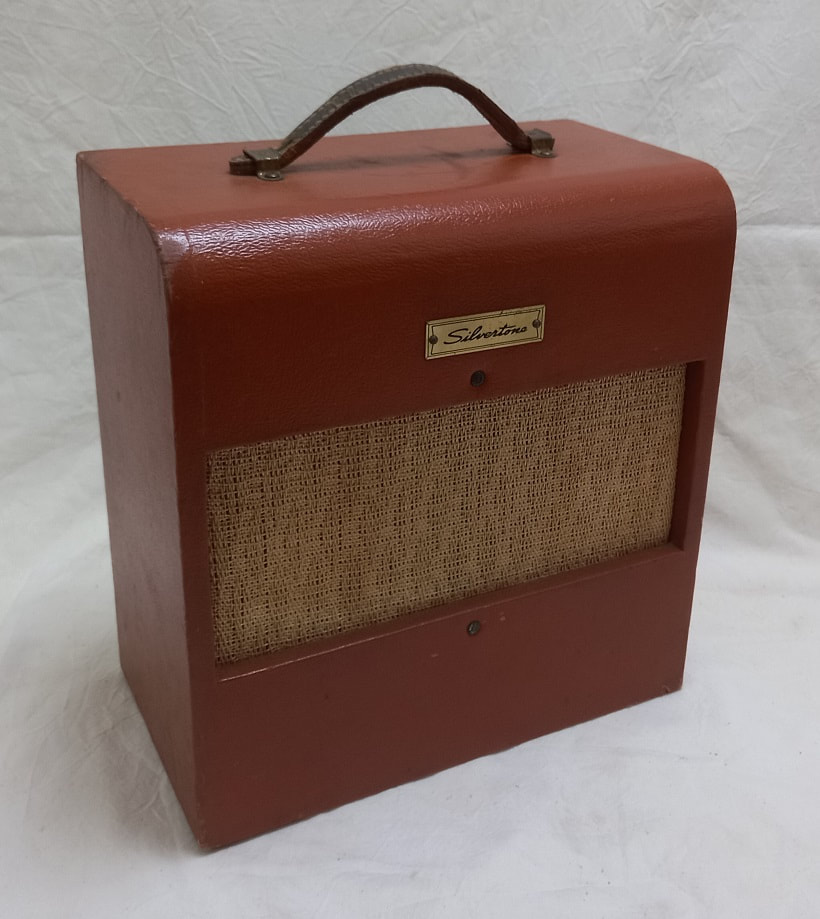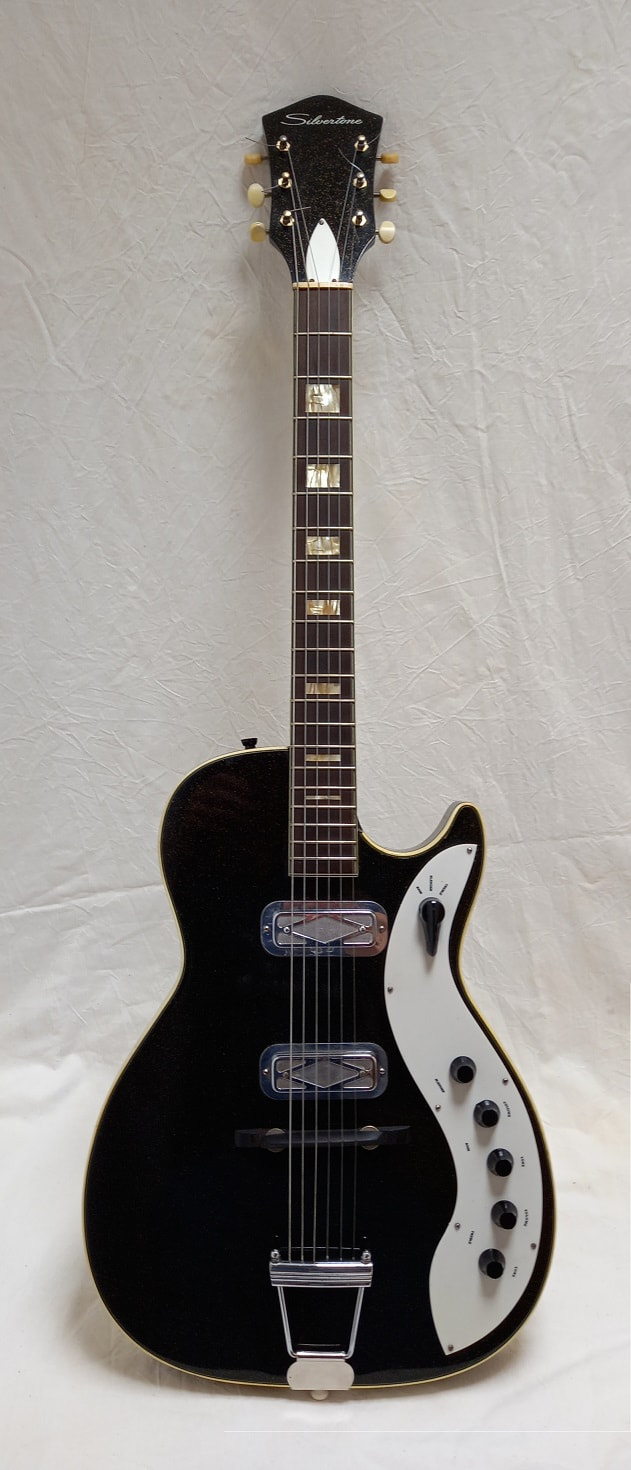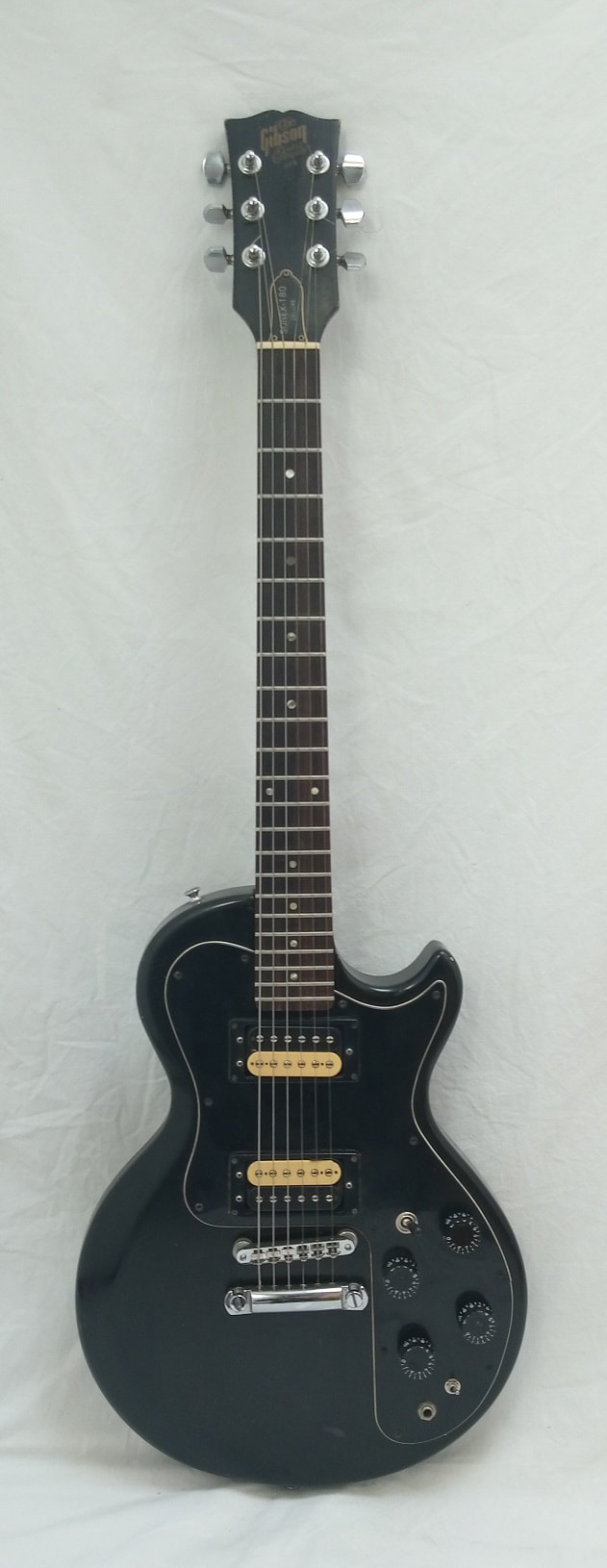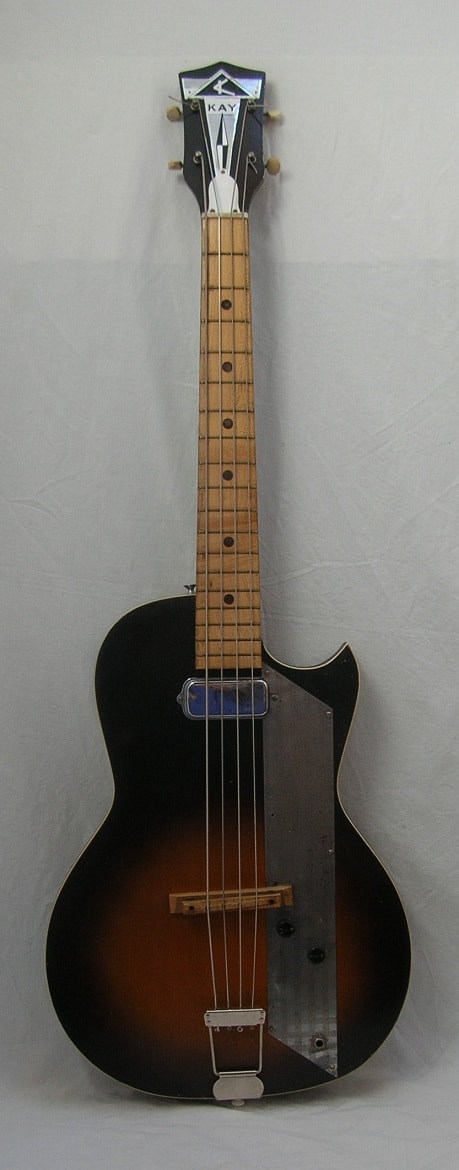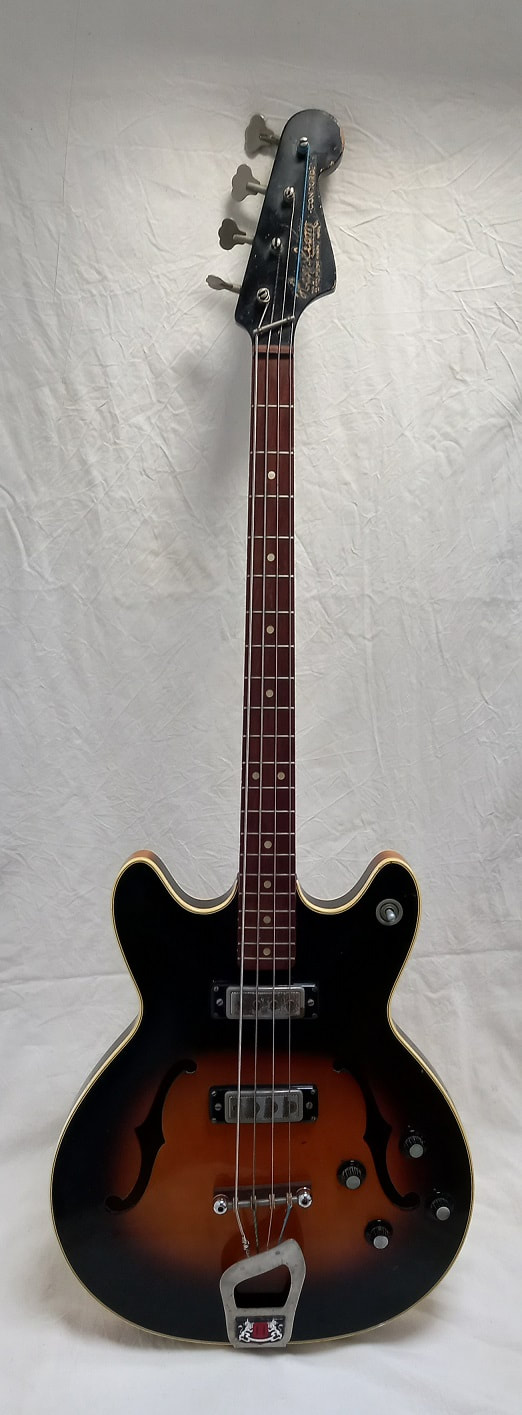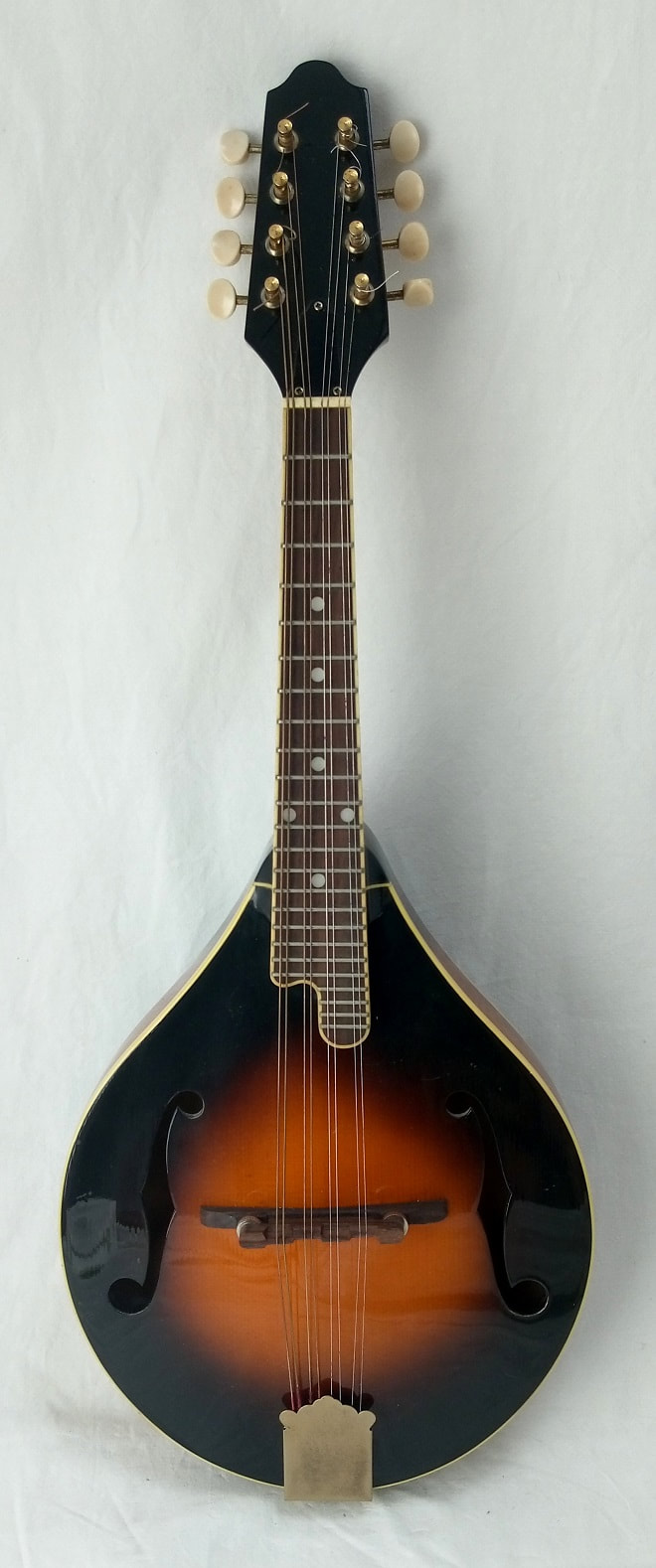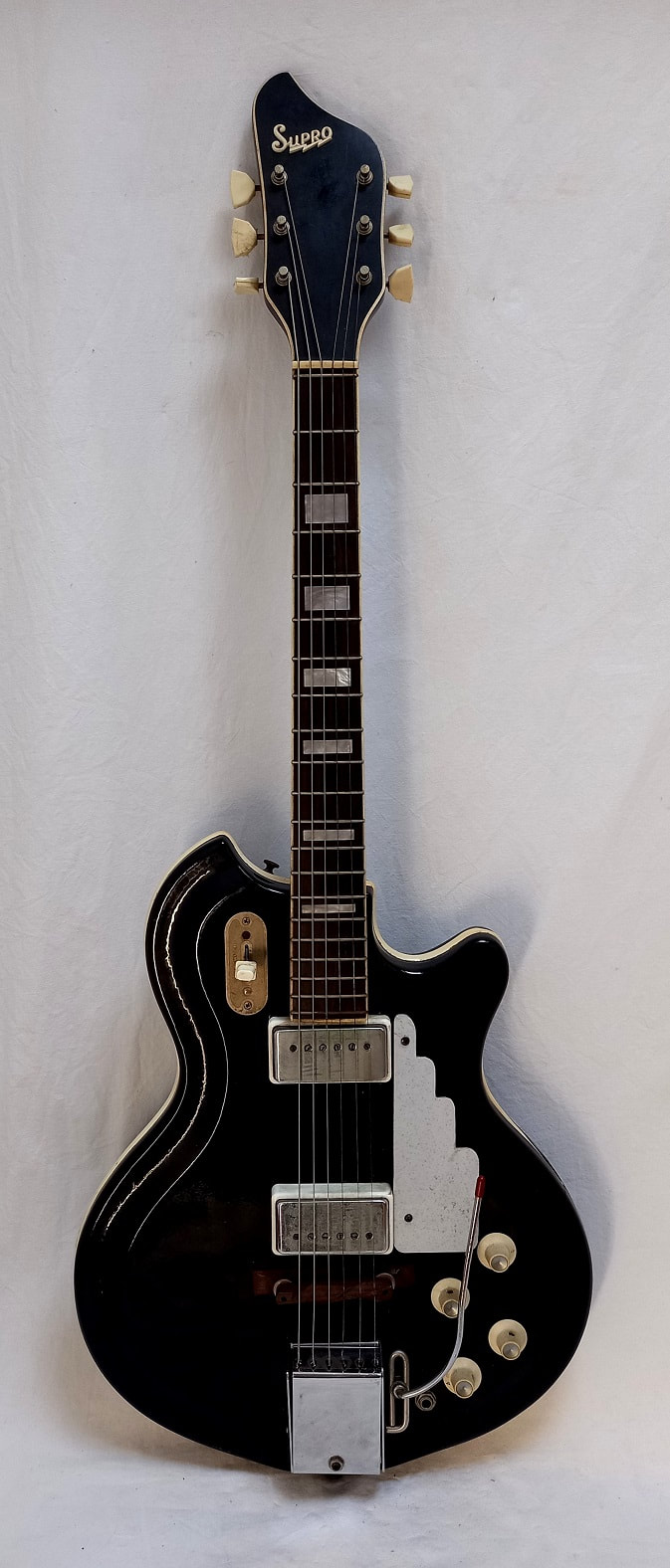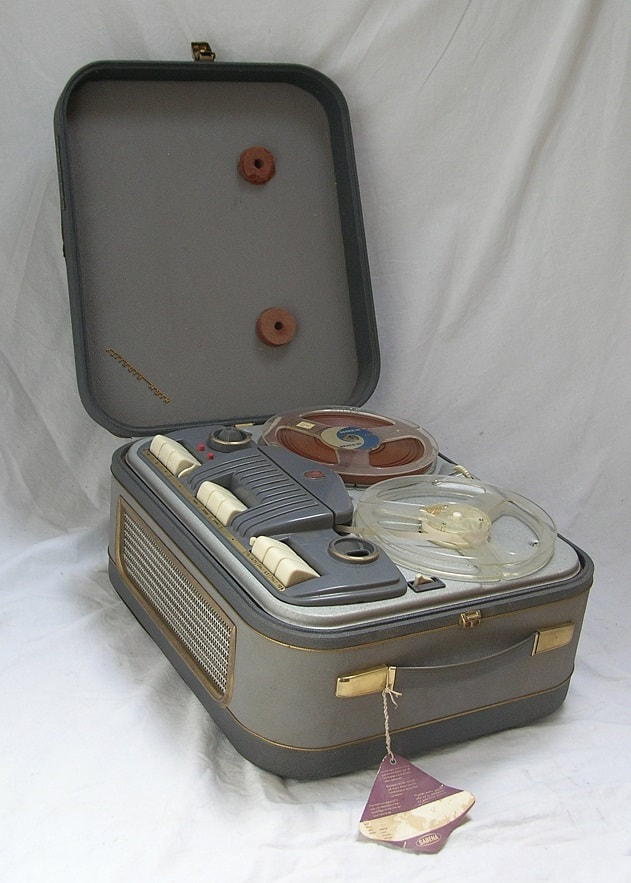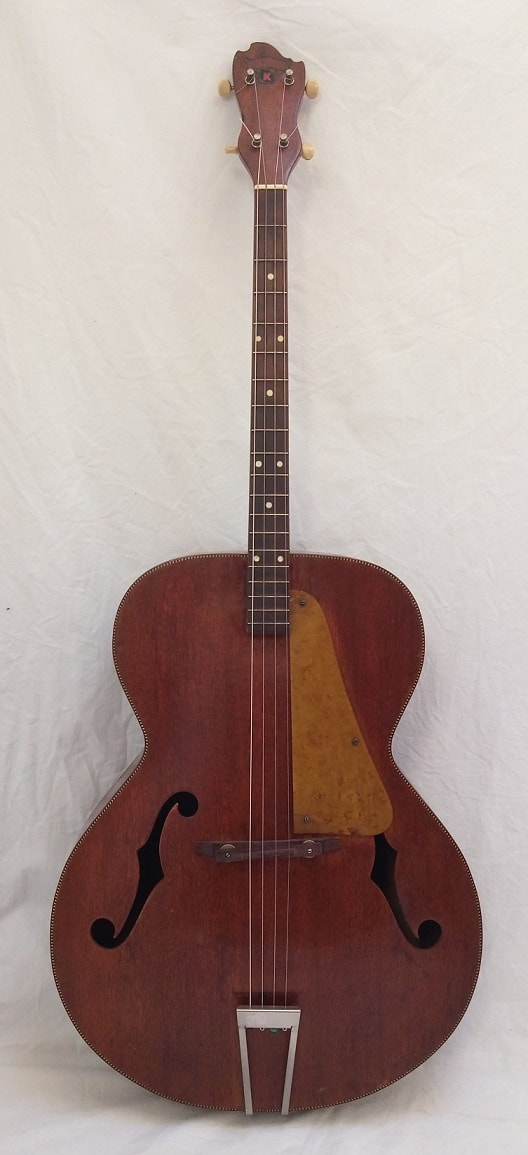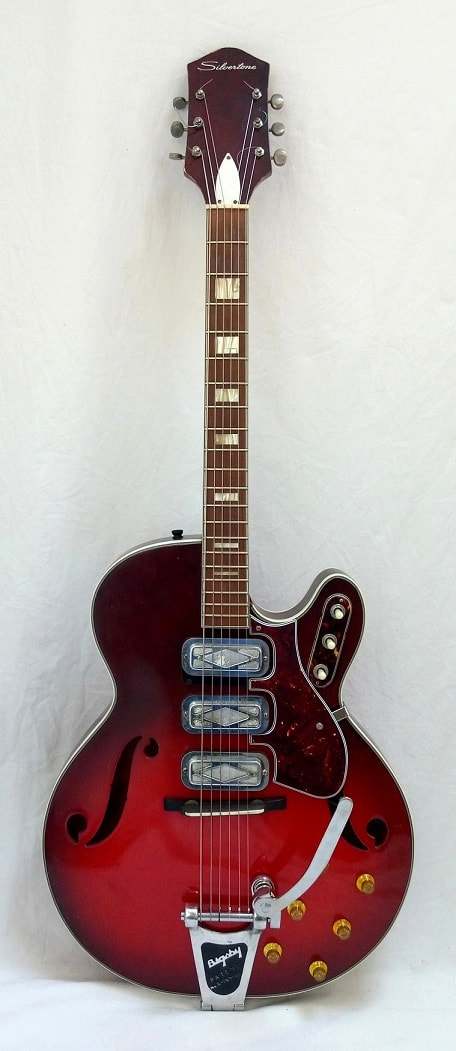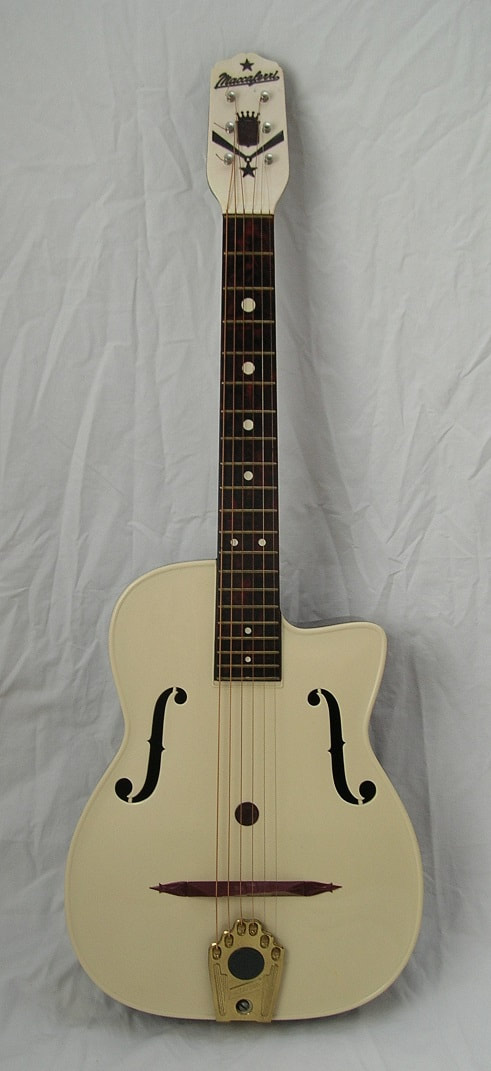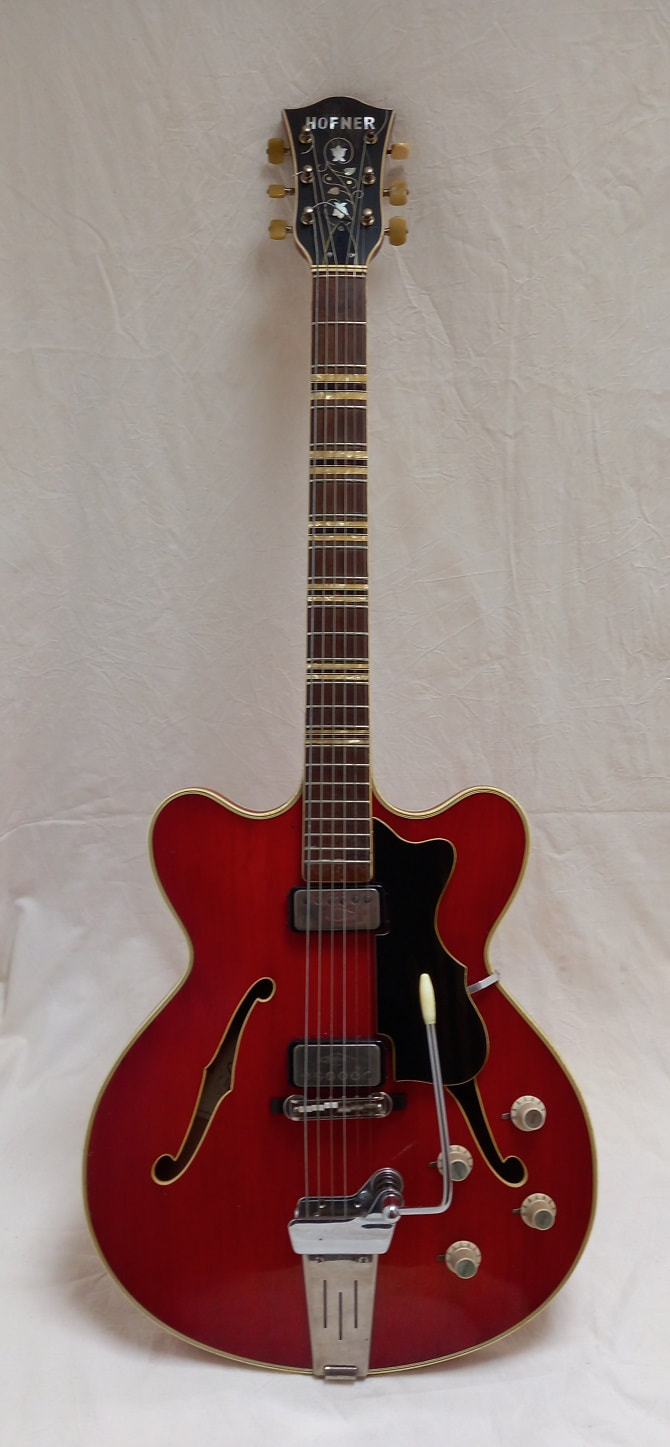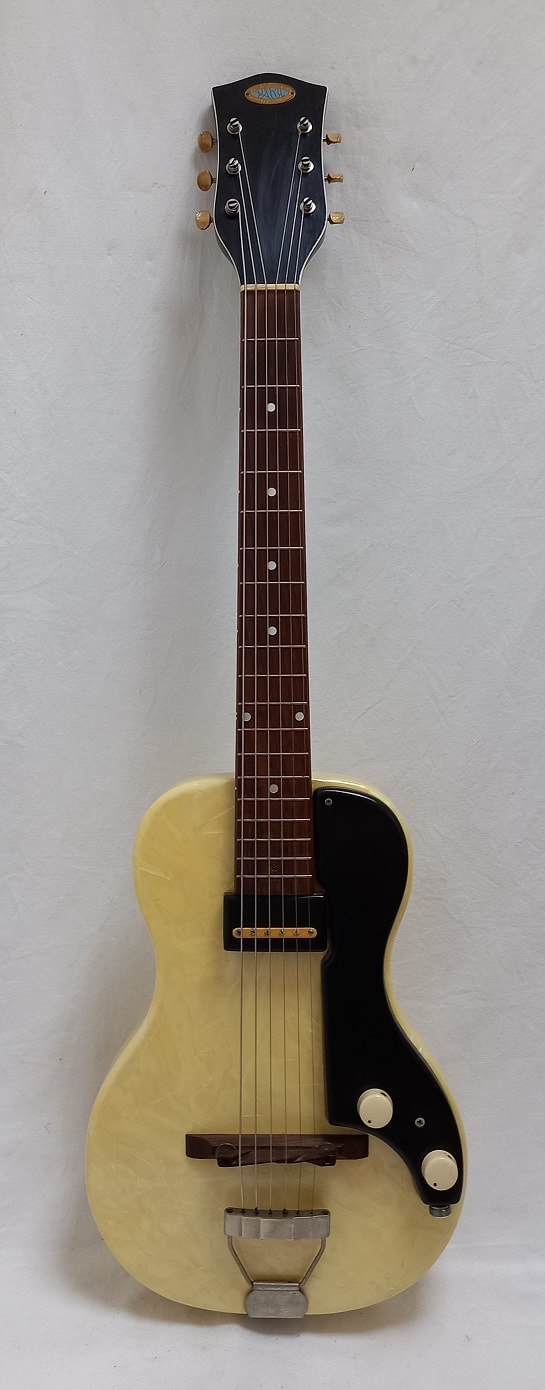TWO STORIES, TWO COLLECTIONS
Hello everybody,
For the time being, no "new instrument of the week" will be published on the website dedicated to my collection of fretted instruments 1920-1970. A period full of new projects and activities is coming up! This does not mean that our weekly exploration stops. There are more instruments to get acquainted with, and a large synthesis is being worked out. In the meantime: thank you, and enjoy the story on our site to the fullest.
For the time being, no "new instrument of the week" will be published on the website dedicated to my collection of fretted instruments 1920-1970. A period full of new projects and activities is coming up! This does not mean that our weekly exploration stops. There are more instruments to get acquainted with, and a large synthesis is being worked out. In the meantime: thank you, and enjoy the story on our site to the fullest.
Selmer-Maccaferri style Gipsy Swing guitar, c. 2009
|
In 1932 a series of newly designed acoustic guitars was created by Italian guitarist and luthier Mario Maccaferri in collaboration with French instrument manufacturer Henri Selmer in Paris. That was just after Gibson had introduced its L5 model f-hole archtop, in a similar attempt to develop guitars that could be heard amidst loud instruments in jazz orchestras. Soon however the Selmer-Maccaferri guitar would be associated with the typical “manouche” gypsy swing ensembles that usually only exsisted of string instruments. It features a fairly wide body with rather square bouts, and a cutaway that was perpendicular to the neck. A movable bridge was flanked by “moustache” markers fixed to the soundboard to keep the bridge in place, and the strings are attached to a unique trapeze-style tailpiece. The top made of a two millimeters thin flat board of European spruce is slightly bent so a gentle arch appears. As on most French and Italian steel strings of the time both top and back are ladder-braced. The neck, with its D-shaped profile, has a relatively wide fingerboard and a 12th-fret neck joint typical of a classical guitar. The scale however, at around 640 mm, is very similar to other contemporary guitars, including most US made dreadnoughts. The snakehead-shaped slotted headstock holds closed tuning machines specially designed for Selmer. Originally the guitar had a large, D-shaped soundhole, and was actually designed to accommodate an internal wooden resonator with a single opening, as invented by Maccaferri. This device should even out variations in volume and tone between different strings, and somehow acts as a bass reflex, thus altering the EQ of the guitar. But after Maccaferri's association with Selmer ended in 1934, the company changed the design, probably to simplify production. The D-shaped sound hole, aka "grande bouche" was replaced by a small oval one “(petite bouche”), while the neck joint was moved to the 14th fret, thus increasing the scale length. Selmer initially replaced the original Maccaferri-patented resonators with a simpler version with two small holes. These would prove less effective and even comes loose too often, so most owners had them removed later on.
Selmer never made a total of more than 1000 guitars and stopped all production by 1952. Even still in the 1930’s, European makers such as Busato and Di Mauro started manufacturing guitars based on the Selmer-Maccaferri models, and from the 1940’s on mainly French and Italian luthiers took over: Favino, Patenotte, Jacobacci, Anasatasio, the Gérôme Brothers, Couesnon (see week 83), Olivieri, Rossi, Bucolo, and many others. In France the tradition lives on with Jean-Pierre Favino and, more recently, Maurice Dupont. This type of guitars with the typically "trebly”, dry sound defines a third point on a triangle, with the normal American-style flattop and a normal American-style archtop in the two other corners. Reinhardt immediately embraced the soloing potential of the later long-scale Selmer with its oval soundhole. Over time, the D-hole models would become the standard rhythm instrument whereas the "petite bouche" model with its loud and cutting voice would remain the design preferred by lead players. Thus the original lineup in Django's Quintette du Hot Club de France is still reflected in many modern manouche-ensembles. Nowadays, the Selmer-Maccaferri guitar is indeed almost completely associated with Reinhardt and the gypsy-swing playing style. |
Airline lap steel
|
I bought this lap steel from someone in Okechobee, Florida in 2009 for only US $ 55.95 (the equivalent at that time of c. 37.16 euros). The description was as follows: “For auction. Please see pix (sic) for best description. She is banged and beaten and painted and beat (sic). Needs restored or needs to be a clock. Questions? As is. Pickup is there. I have no idea if it works. Missing all else, as is. Klusons are good parts“. So when it arrived, I tested the electronics, and luckily everything worked. In addition, the original black finish and the white fingerboard layout appeared from under the ugly gray paint when I removed it. I decided not to turn it into a clock! Now this electric "Hawaiian", made by Valco, has been revived as the nice sounding and playing workhorse it was intended to be. Branded "Airline", this Lap Steel model first appeared in the catalogue of the Montgomery Wards department stores in 1958 and was available until 1967, the year Valco ceased to exist. It is very similar to the Supro Comet by the same manufacturer launched a decade earlier (see week ...) which remained in production until 1966.
During this time, the Supro underwent a number of changes, while the Airline stayed the same for almost ten years, including the black finish. In reality the white Daka Ware knobs in the catalogue were normally smaller black ones. Our example still has the original black felt on the back and the original Kluson Deluxe tuners, which turn nice and smooth and stay in tune very well. The pick-up, with its adjustable pole pieces, has the typical Valco sound and gives an adequate signal that is incredibly powerful and clean, without static or hum. Simple and effective as it is, this model must have been quite popular, given the number of originals still popping up regularly. All in all it is just a wooden plank with painted decoration, featuring quality spare parts: decent tuners and a good pickup with volume and tone controls mounted on a simple metal plate with a bridge and some holes for attaching the strings. |
DeArmond and other detachable pickups for string instruments
|
The Rowe-deArmond brand is forever linked to easy-to-install pickups that could be affixed or detached without damaging the instrument. Two men, both born in 1906, kept production going for more than three decades between 1939 and 1975 in Toledo, Ohio. The first, Harry DeArmond, born in Clinton, Kentucky, was an electric designer and a tinkerer. In 1935 he made a pickup for his younger brother John from the ignition coil of an old Ford Model A. Realizing the commercial potential of an attachable device, he started up a pickup-building operation, together with Horace “Bud” Rowe of Fox Sound Equipment Corporation in Toledo. In 1939 they brought out two models: the RH (round-hole) fitting inside a flat-top guitar's soundhole, and the FH (f-hole) fixed to a rod parallel to the guitars low E-string. The RH was held in place with adjustable springs and projected only a few millimeters above the soundboard. For the archtops with f-holes a more ingenious method was necessary: the rod, which passed through a small hole on the left side of the pickup, was strategically bent to go around the bridge. It was then fixed to an assembly, the “string clamp” with two serrated screws pressing the strings between two metal slats just below the bridge. The pickup slides ingeniously along the length of the rod from bridge to neck, allowing the player to adjust the pickup's location for preferred tonal character and for minimal interference with performance. Later an option was offered with a shorter pressure rod that could be attached to the bass side of the fingerboard with two small screws. Both the RH and the FH were also available with a volume-control: the “RHC” and “FHC” respectively. The “Rhythm Chief” archtop pickup model 1000, introduced in 1948, and especially its successor from 1954, the 1100 with individual pole-pieces, are considered among the best pickups ever produced. It is often seen on D'Angelicos, Guilds, and other top-of-the-line archtops. A pickup with similar accouterments, but for flat top guitars was called the "model 210".
DeArmond detachable pickups were copied by Kent, Kiesel, Lafayette, Sekova, and other brands. The "guitar microphones”, as the packaging referred to them, gave players from the depression-era a way to go electric without buying a whole new instrument, at the same time allowing it to be amplified without disturbing the acoustic sound or damaging and dampening the wood. Originally the main users of DeArmond pickups were guitarists seeking a clean sound and looking to be heard above wind instruments and drums. To promote the quality of his pickups, Harry DeArmond developed a tapping technique, later adopted by guitarist Jimmy Webster, and popularised forty years later by players such as Steve Vai and Eddie Van Halen. When he retired in 1975, more than 100 different pickups for guitar, mandolin, banjo, ukulele, violin, double bass… had been designed and manufactured, together with amplifiers and effects units. DeArmond also created contact microphones for all kinds of stringed instruments, and many guitars by Harmony, Epiphone, Premier, Fender, Gretsch and Guild had factory-fitted Rowe-deArmond pickups with very characteristic and much wanted sounds, including the “Dynasonic “ models. |
Egmond Solid 7, 1959
|
The Solid 7 was launched around 1957 as a more "electric" looking counterpart to the Lucky 7. While the latter had a more classic outline with only one cutaway and f-holes, the Solid 7 had a very thin hollow construction without any sound hole. This made it light and resonant while maintaining the appearance of a solid body. A floating pickguard with integrated pickups and controls was attached to the top, the number of the two pick-up models was "ES113/22M2CA", the model with three pick-ups was the "ES113/23M2CA", also known as the "Super" Solid 7, usually equipped with a vibrato unit. A “Bass 7” was also issued on the guitars. Originally the Solid 7 had two symmetrical cutaways but around 1959 Egmond came up with a new slightly asymmetrical double cutaway design. A year later, the PP2 or PP3 plectrum-plates changed from black to white, while the headstock was modernized to take an elongated shape with the tuners all on one side. The bound neck has 20 frets and four round position markers. The neck just bolts straight onto the thin hollow body with two screws, so there's no neck pocket and no truss rod. Over time, most of these necks would end up with a concave surface due to the string tension. Sometime around 1964 the Solid 7 models got truss rods and two years later they were renamed "Flash". In the early 1960s, the Solid 7 flooded the Belgian and French markets and many are still popping up at flea markets and online sales. The model also reached the UK and Ireland, often branded "Rosetti" and distributed by Bell. A number of leading musicians had one early in their careers. Paul McCartney used one during the Beatles' first stay in Hamburg, and later turned it into a bass by fitting three piano strings onto it. Rory Gallagher's first electric guitar was also a Rosetti Solid 7.
The 1959 redburst Solid 7 in this collection features the older symmetrical headstock with tuners on both sides. It has a long tailpiece that doubles as an "all-in-one" bridge, and a black PP2 "Royal" pickguard with rounded ends for the pickups. It includes a volume and tone knob, and there is one on/off switch for each pickup. The din plug is mounted on the top, unlike many Solid 7's back then, which only had a cable with an output jack coming out from under the pickguard. Egmond pickups produce a nice warm vintage sound, and curiously enough they are out of phase by default when both are on. If it weren't for the thin body and unstable neck construction, the Solid 7 would be a perfect choice for gritty blues and the like. |
Chris Adjusomatic model 125, c. 1960
|
The Jackson-Guldan Violin Company from Columbus, Ohio was a prolific manufacturer of cheap violins, viola, cellos and the like in the first half of the 20th century. Most were student instruments made of inexpensive material, but quite well made. In the 50s and early 60s, Jackson -Guldan also made guitars, mainly for presentations and "theme" instruments with brand names such as "Champ", "Dart", "Jay", “Meteor”, "Blue Suede" and "Chris". These “Adjustomatic” models were provided with a unique adjustable neck and bridge. The thin-lined neck can be removed or adjusted in no time. A long screw holds the neck in the body, while a thread bolt rotates against a small piece of 90-degree corner iron to change the neck tilt, making it easy to adjust the string action. Although they were cheap guitars, the craftsmanship was generally first class. The company was in operation from 1915 to 1971, when the import of German violins led to its slow decline.
This strange little "Chris Adjustable model 125", made around 1960 by Jackson-Guldan, is somewhat a rare bird. It was made entirely of solid birch like so many low-cost guitars. The label inside reads "This is an Adjustomatic guitar. Turn clockwise to lower height of strings. Turn counterclockwise to raise height of strings. Made in America.”The "Kluson Deluxe" tuners illustrate the wishes of the manufacturer for excellence. Interesting is that the guitar is well preserved and has a superior tone for a birch instrument, with impressive bass response. Unfortunately the back, finished in a faux flame, is set crooked, just like the neck and the sound hole, making it hard to adjust this guitar. Anyway, it looks like it was made on a Monday, so it does not reflect the pursuit of quality that you would expect. |
Broadway "Budget",
|
The brand name "Broadway" was used by British distributor Rose-Morris for instruments, mostly guitars, bought in the UK or imported from Germany or Japan. In the late 1950s and early 1960s, two Broadway models, the BW1 with one and BW2 with two pickups made by Henry Weill, were available. The necks and bodies were most likely manufactured by furniture maker Stuart Darkins & Co. from Shoeburyness in Essex, who also produced solid bodies for other guitar manufacturers. The February 1961 Rose-Morris catalog featured a Broadway bass alongside two new solidbody guitar models: the two "Plectrics," made by Guyatone in Japan. Both had oversized oval chrome single coil pickups, the "Plectric 1921" had one, the "1922" had two. More 'Plectric' models were produced for Rose-Morris over the next two years, usually available through mail order companies or through outlets such as Bell Music in Epsom.
The "Budget" models, which were launched in 1962 as cheaper variants of the "Plectrics", had the same type of pickups as the "1921" and "1922". The two-pickup model as in this collection was equipped with a double spring tremolo unit. The deep maroon nitrocellulose clear finish of the Plectric range is replaced by red lacquer on the "Budgets". The body had a slightly different shape and was made of plywood instead of solid mahogany. A strange combination of a dovetail and four-bolt with neck-plate construction was used in place of the Plectrics' set neck. The surface of the unbound fingerboard with simple dot markings is straight, which is rather unusual for an electric guitar. A steel bar is fitted underneath, so there is no adjustable truss rod. A small piece of plastic simply covered the end of this rod. The Fender-style headstock consisted of a six-in-line set of open-back tuners, with white plastic knobs and ferrules for the tuning posts. The T-shaped string retainer bar can also be found on other Japanese guitars at the time. The Broadway logo is long gone. A tone and two volume controls are mounted on the preloaded white pickguard, with rhythm and solo switches for each pickup. The old din output plug has been replaced by a modern 6.3 mm jack. A two-piece metal saddle bridge, with two thumbwheels to raise or lower the string height, was screwed into the body. The chrome cover is missing from the tailpiece, as with many guitars available on the second-hand market. As the name implies, the "Broadway Budgets" price was kept low using inexpensive materials to allow beginners to ease their way into guitar playing. |
Oahu amp by Valco, 1952
|
Here is a nice sounding and good looking American amp from the early 1950's. It has a 10 inch alnico speaker made by Rola for Valco, as the number "550" on its back indicates. It is equipped with two 6V6GT power tubes, a 5Y3GT rectifier and two 6SJ7GT preamp valves. It's not very loud, somewhere between 6 and 15 Watts, but it has a warm, thick, creamy overdrive and produces that typical Valco tone with clear highs and deep bottom end, combined with richness and detail in the midrange. This makes it perfect for recording or living room performances, delivering some of the best tube amp sounds ever. The black control panel, with white lettering, shows three inputs, an on/off switch and a fuse holder, and in the middle between the volume and tone knob "Valco Chicago 51" in a stylish "V"-shaped logo.
So this is a "Chicago 51" model from Valco? Not at all! 51 was simply the two-digit code referring to the specific zone in Chicago where the amps were made. The exact same chassis, including the "550" Rola speaker, all made sometime between 1950 and 1956, can be found in cabs with different designs and different make and model names: National, Supro, Gretsch, Dwight, McKinney Guitars, etc. But this example, sporting the metal "Oahu" badge, is dressed in a much more stylish cream tolex trim paired with black speaker grille cloth behind three horizontal slots. We couldn't find the exact same amp in any Oahu catalog from that era, so maybe it was part of a set that included an Oahu "Spanish" guitar or lap steel, or it was only offered to people following some course organized by Oahu . Either way, this would be a perfect match for the 1953 Oahu solid body from Week 105. |
Kay Swingmaster K673, c. 1963
|
Sidney Katz, who succeeded Kay director Hank Kuhrmeyer in 1955, introduced the so-called "Gold K" line of archtop and solidbody electric guitars in 1957. It was a rather unsuccessful attempt to compete with Fenders, Gibsons and Gretsch's more expensive electrics. There were some issues with the set up, truss rods and fret jobs. Nevertheless, this effort resulted in some nice models such as the Swingmaster. In 1961, the K672 with two pickups and the K673 with three pickups replaced the old K6970 and 6960 Swing Masters, now equipped with better pickups but also less prized bolt-on necks. That same year marked the introduction of several other models with a similar neck-to-body joint, such as the “Speed Demon” (see week 94) and the “Vanguard”.
The Swingmasters were fancy workhorses, but less decorated than the "Barney Kessel" model that inspired them. The semi-hollowbody with laminated, slightly flamed maple back and sides is a two-tone sunburst with a rounded cutaway and checkerboard binding. The three-bolt maple neck features a bound Brazilian rosewood fingerboard with pearl block inlays. The so-called "Kelvinator" logo of the "Barney Kessel", with "Kay" written under a painted plastic overlay, has been replaced by the budget-friendly "K" silkscreen logo printed on the headstock. However, many Swingmasters carry a "Custom Diamond" logo, referring to an obscure wholesaler, in a manner similar to the Truetone "Jazz King" from Week 94. Similar to the Barney Kessel, however, is the use of single coil “Gold K” pickups towering on top of this guitar. These are actually "P-35s" with adjustable pole pieces, wound for Kay by Gibson, with more top-end brilliance than Gibson's P-90s, but with a cool 50s vintage look: they are commonly called "Kleenex box" pickups due to the resemblance of their clear silver plastic covers to a tissue container. This 3-pickup K673 has volume and tone knobs for each pickup, and a 4-way selector switch in the top shoulder, which activates the pickups individually or all at once. All in all an attractive instrument that is pleasing to the eye, and with a sound of its own. |
Arirang LEG500 neck-through, c. 1980
|
One of the first neck-through guitars was also the first solid-body electric bass guitar ever made: the "Audivox 736" made by Paul Tutmarc around 1937. Strictly speaking, however, the 1935 Electro Spanish guitars from Rickenbacker (see week) came first. There are some advantages to this method of construction: it allows easier access to higher frets, as no heel is required, and some say it offers greater sustain and allows the instrument to stay in tune much longer. Because it is rather labour-intensive, it is more often used by independent craftsmen than by mass-producing companies. Nevertheless, it was quite popular in the 70's and 80's as evidenced by this Arirang guitar. Parker, BC Rich, Yamaha, Cort, Ibanez, Jackson, Alembic, Schecter, Carvin, ESP, Rickenbacker and many more have all manufactured neck-throughs.
The guitar making company "Arirang" is named after a Korean mountain, but it is also the title of a very popular Korean folk song. In the 1970s and 1980s, they produced acoustics and electrics in South Korea, which were apparently quite popular in Spain. Some of these were branded "Austin", not to be confused with the current Austin guitars from Indonesia. Many are Fender or Gibson copies, but others like this LEG500 have an original design that is close to some of the "S.D Curlee" guitars from Hondo and others. This is a 22 fret version of Arirangs popular neck through model. All in all it's a nice double cutaway electric guitar, with two humbuckers, a toggle switch, two tone and two volume knobs and a top mounted output jack. A little gain is enough to make the guitar sound really rich and lively, but even clean you can enjoy the twangy mids and good openness. The maple and mahogany striped neck has a very thick U-profile and a maple fingerboard. It has a natural finish that also beautifully highlights the wood grain of the mahogany body wings. The 1970s Gibson-style harmonica bridge and top bar are original, unlike the Schaller 3 + 3 tuners. |
Gibson Les Paul
|
People want simple answers to simple questions, such as: “who invented the solid body electric guitar”? Immediately two names from the late 1940s- early 1950s come to mind: Leo Fender and Lester Polfus, aka Les Paul. However, neither has “invented” the instrument, just as there is no ingenious inventor of the violin. Both merely contributed to the commercialization of the idea. The birth of the solid body had been a slow process that started much earlier, essentially with the search for louder guitars twenty years before and the development of the electric lap steel or “Hawaiian” guitar. All in all, these were solids, but without a round neck that was reserved for the so called “Spanish” guitars, as normal acoustics with or without pickups were called. The idea of mixing both types to get a solid body with a “Spanish” neck had been realized by a number of men who were ahead of their time: George Beauchamp, Adolf Rickenbacker, Paul Tutmarc, Paul Bigsby and O.W. Appleton. Les Paul merely tried to convince the Gibson Company to use a solid “log” in the center of their archtops, an idea that was eventually fleshed out in the ES 335 model in 1958. The model with fully solid body, launched in 1952, two years after Fenders “Broadcaster” and endorsed by top jazz guitarist Les Paul, had been developed mostly by Gibson employee Ted McCarty , and shared its styling and design with the semi acoustic ES 295 from the same year. Les Paul and Mary Ford, one of the leading vocal duos in the United States at the time, would both play Goldtops thereafter, and the “Les Paul” model would make history.
The goldtop finish was a mixture of bronze powder and nitrocellulose lacquer. Most of the plastic parts such as the jack plate, pickup covers and the pickguard are cream colored, but the back plates are brown. The bold control knobs, which replaced the so-called speed dials in 1955, are clear plastic sprayed from underneath with the same bronze powder finish used on the guitar. The combination of a mahogany body with a maple arched top gave brightness and clarity to the sound, which paired well with the two P-90 single-coil pickups. The one-piece trapeze-style bridge and tailpiece was replaced in 1953 with a wraparound stop-bar tailpiece screwed directly into the guitar’s top. This solved intonation problems, increased sustain and allowed palm muting of the strings. Two or three years later a separate stop bar and a fully adjustable Tune-o-matic bridge combination was introduced, as had been in use on the Les Paul “Custom” since its launch in 1954. That year Gibson added another model to the Les Paul range: the “Junior”, and the following year the Les Paul “Special” became available. 1956 was the last year that P-90 pickups were offered on Goldtops after which humbuckers became standard. The list of musicians who have played on a Goldtop is sheer endless. Hubert Sumlin played two different Goldtops on many Howlin Wolf classics, one with a wraparound bridge and P-90 pickups and later on a 1956 with a Tune-o-matic bridge. Freddy King initially played a Goldtop, and only later in his career did he use an ES 335. Carl Perkins composed the classic “Blue Suede Shoes” on his Goldtop. By 1967, Jerry Garcia of the Grateful Dead was using P-90 pickup-equipped goldtops or black custom models from the mid-1950s, while Duane Allman bought his 1957 Goldtop with humbuckers in early 1969. Neil Young’s old black Les Paul was originally a 1953 Goldtop. Other Goldtop players include Steve Hackett of “Genesis”, Adrian Smith of “Iron Maiden”, David Gilmour, Slash, The Edge, John Fogerty, Keith Urban and Derek Trucks. The Goldtop: a guitar you can't ignore. |
Arnold Hoyer, model 20 II “Solist”, 1950s.
|
As a guitar brand “Hoyer” originated in 1874, when Franz Hoyer, following his family tradition of making string instruments, opened his own workshop in Schönbach. After WWII, Franz Hoyers son Joseph settled in Tennelohe near Erlangen, concentrating on flattops, but soon Franz’s grandson Arnold took over. Arnold reorganized the company and after a few years the brand became known for its quality archtops. When he died, his son Walter A. Hoyer took the lead, now focusing on electric and steel-string guitars. In the fifties and sixties the “Solist” was very popular, but it was not as exclusive as the “Special or the “Special SL”, nore as experimental as the “Bianka” or the “Fantastik” models. The “Solist” had a natural, sunburst or black finish and two main versions with many variations were available: plain with a spruce top and a maple back, or fancier with a top featuring alternating strips of spruce and mahogany, and bound with triangular wood pieces. Electric “Solists” have also been produced.
The version in this collection, originally an acoustic, has the rather rare black gloss finish and is provided with a floating unit by Framus, consisting of a metal pickguard, and tone and volume knobs for each of the two single coil pickups. The body is bound with multiple celluloid strips, and has a deep Venetian cutaway and long cat’s-eye sound holes, while the arching and the fluting around the edges are quite pronounced. The ebony bridge has metal rollers for adjusting the length of each string individually. The original Art Deco style tailpiece has been replaced by a German-made vibrato unit. The spruce top bares a logo with “Original Arnold Hoyer Gitarre” written in gold. The slim D-shaped maple neck has no truss rod or metal rod for reinforcement, meaning this instrument was made before circa 1960. This corresponds to the white and red bar-shaped pearloid position markers, later generally replaced by small diamond shaped inlays. The ebony fingerboard has 21 frets plus a zero fret. The 3 plus 3 tuners were plain with pearloid buttons. The small brass staff under the “Arnold Hoyer Solist” inlay on the headstock has probably been added later. The guitar does not sound loud but quite jazzy. A natural finish “Solist” has been used by Anton Knollenberg, aka Tonny More (1922-1985), singer-guitarist of the Dutch “Cocktail Trio” from the sixties. |
|
This instrument dates from the period just after Valco bought the Kay company in 1967, a last ditch attempt to reverse the downward trend that had begun after the mid-decade. Although Kay was the larger company of the two, they opted for a takeover by the smaller Valco. It was thought that both manufacturers no longer had to compete with each other in the field of electrics, in which they were both strong, so Kay's acoustic division could be better supported. Apparently quality parts from the stock of both companies were merged to reduce costs and still bring attractive guitars onto the market: mahogany for the back and sides, spruce for the top, maple for the neck and bound Brazilian rosewood with large block inlays for the fingerboard. A similar guitar was sold as the Supro S670.
Most of these instruments had decal rosettes and pickguards installed, but maybe this example never got to that stage. The super-auditorium-style bound body and the height-adjustable bridge with pointed base are clearly of Kay-signature. They are very similar to the natural finished Kay K6170 and cherry finished K 6175, which were in production since 1966. The three-bolt maple neck is made in the Valco factory, as the gumby headstock and double-line Kluson Deluxe tuners with tulip-shaped knobs indicate. All in all the result is a good looking and great sounding guitar with a big booming voice, plenty of volume and sustain with a crisp attack and balanced tone. However, efforts to combine the best of both worlds came too late to save the newly merged company. |
Silvertone tube amplifier, Model 1430 (by Danelectro),
|
The model 1430, made by Danelectro, had a longer run than any other Silvertone amplifier. Very similar to Danelectro’s own “Cadet” model, it appeared in the Sears catalog virtually unchanged from 1954 to 1965. Introduced as the “1330”, it was later named the 1390 “Meteor” for a short period between 1957 and 1961.These cheap but reliable little amps looked pretty cool and sounded great. They sold well and were common entry-level amps in the 50s and 60s, so no wonder there are still many of these on the American vintage market. While not particularly safe, their circuit was simple but effective, with one input jack, an on-off switch, and one volume control. With all point-to-point wiring and three tubes, 12AU6, 50C5 and 35W4, they produced between two and three watts of output into a 6 inch Jensen speaker This is not much, but enough for rehearsals and small venues. According to the catalog, the input jack was intended “for instrument or microphone”, and these models do indeed perform very well as harmonica amps. An affordable microphone could be picked from the same Sears catalog anyway. Definitely a 1430 could not be missing in this collection of common-man fretted instruments and matching gear.
|
Silvertone 1423L
|
Introduced in the fall of '59, the Silvertone 1423L was one of the more expensive offerings in the Sears Roebuck & Company catalog. It was a rebadged Harmony H49 Jupiter Stratotone, and that is why it is commonly referred to as the "Jupiter", although the term was not used by Sears in any of its sales literature. While the H49 was produced until 1965, the Silvertone version was dropped from the Sears catalog in 1963, although the gold-sparkle-black-finished 1423L, with its white worm-shaped control plate and silverfoil DeArmond pickups in diamond-cut silver grille covers, is at least as attractive as its Harmony sister model with its blonde natural finish, spruce top and tortoise-shell pickguard.
Like all models in the Stratotone line (see week 75), both guitars have lightweight chambered single cut bodies, this time with multiple bound tops and backs. The rosewood fingerboards with block inlays, have multiple binding, while the headstocks feature three plus three separate Waverly tuners. The chunky short scale necks are bolted on with three large screws, arranged in a triangular formation. The phenolic Daka-Ware knobs, made by Davies Molding, are the same size as the ones used on the Bobcats (week 17). In addition to separate volume and tone controls for each pickup, the guitars feature a “blend” knob, which operates when the three way switch is in the middle position. It changes the balance between the two pickups creating an almost 'Wah pedal' tone when turned back and forth. Combined with the acoustic resonance of the hollow bodies, the Dearmonds sound clear, bold, strong and dynamic and when cranked up they can push a tube amp into tonal heaven. |
Gibson Sonex 180 Deluxe, 1982
|
This guitar illustrates how some major USA manufacturers such as Gibson have been trying to counter the harsh competition from the Far East since the late 1960s, by taking their share of the budget market. The Sonex line was launched in 1980 to replace the Marauder and S-1, all based on the Les Paul. The “Multi-phonic™ body” of the four Sonex models Deluxe, Standard, Custom and Artist was made of a synthetic material called Resonwood, surrounding an inner tone wood core, which not only acts as an anchor point for the neck, but also adds acoustic resonance and exceptional body resilience. By 1981, the Standard model was dropped in favor of the more expensive Sonex Artist, which was equipped with newly developed active electronics.
The 180 Deluxe, Gibson's cheapest guitar at the time, would outlast all other models until 1984. It had less ornamentation and a bolt-on neck with a rosewood, dot-inlaid fingerboard, and the headstock with a new, non-script Gibson logo. It featured two exposed Velvet Brick humbuckers designed by Bill Lawrence who was working for Gibson at the time. These 'zebra' pickups with black and cream coils had a steel mounting base which is different from other Gibson pickups, with 2 screws on one side and one on the other for adjusting the height. The guitar came with a three position selector switch, Tune-0-Matic Bridge, stopbar tailpiece and speed knobs for volume and tone controls. At some point in the existence of this particular guitar, a small switch was added to split the humbuckers and turn them into single coils. The sound quality is not bad at all for an instrument with a modest price tag. In any case, it was good enough for Thurston Moore of Sonic Youth to be played it with drumsticks strung with four strings and with the frets removed. |
Airline by Valco amp in case model 7214
|
The combination of a lap steel guitar and a matching case with a built-in tube amplifier came into its own between the two world wars. A number of manufacturers sold such sets, such as Valco’s Supro model “60”or Harmony’s H20 Consolectric Lap Steel-Table set. Some were distributed through one of the mail order companies in or around Chicago, for example Silvertone model 2323 by Valco, Or Oahu model K369, basically a Dickerson Black Pearl lap steel paired with an amp-in-case (see week 51). Later the idea was applied to normal "Spanish" guitars. It is a practical and cheap configuration and a very simple concept: you arrive at your gig, take out the Guitar, plug it in to the guitar case and just start playing. About 1959-1963 wholesaler Mongomery Wards offered the Airline model 7214, again by Valco. It predated the famous Danelectro-made Silvertone amp-in-case models by a few years: the 1448 with a single lipstick pickup, the 1449 with two. Their cases had small built-in amplifiers with 6 inch speakers, and the guitars, very light due to their hollow body construction, had short-scale 18-fret necks. The Silvertone 1457 model came out in 1964 and was the higher-end model with an 8 inch speaker and a two pick up redburst electric guitar with “sparkling silver color accents” (see week 10).
The Airline 7214 was certainly a good alternative to the Silvertone models, but a bit heavier, despite the thin, lightweight alder or poplar guitar body. The guitars were available in a variety of finishes but black or white were the most common. The body had one cutaway and featured a compensated Brazilian rosewood bridge and a simple metal tailpiece. The bolt on neck is wide and comfortable, with a chunky feel to it. It is painted black and quite thick for a short scale guitar like this. The unbound Brazilian rosewood fingerboard with 20 frets has pearl dot position markers. The white button tuners are marked “Kluson Deluxe”, and the Valco serial number plate on the back of the symmetrical headstock puts this guitar in the 1960 range. Tone and volume controls are mounted under the black plastic housing just like on the Oahu “Ozark” guitar (week 105). The Valco designed singlecoil pick-up, hidden under a black metal cover the size of a humbucker, has the same qualities again. It can really drive the amp, with plenty of midrange combined with lots of top end clarity. It has great articulation and tight attack. The durable and damage-resistant case was available in a variety of finishes, this one being beige tolex with a “gold” grill cloth. It is a single end 6V6 tube circuit combined with a Jensen 8" alnico speaker. The amplifier is comparable to a late-1950's Fender Champ: well suited for getting great natural sounds at a reasonable volume, and sweet singing harmonic overdrive. |
Kay K5961 Value Leader bass, c. 1962
|
Even before electric basses became commercially viable, Kay had been known for affordable acoustic double basses and cellos since 1938. No wonder they introduced an electric bass as early as 1954: the K5965 Pro model, and soon after, the K160, which was very similar to the K161 “thin twin” guitar (week 82). The K5970 "Jazz Special" however, produced between 1960 and 1964, would become their flagship bass model. All of these were aimed at professionals and semi-professionals, and were often found in the hands of blues bassists. In the same year as the "Jazz Special", Kay launched an affordable short scale bass as part of the "Value Leader" line, designed for beginners and musicians on a budget.
This instrument is almost identical to the “Value Leader” K1962 and K1963 guitar versions (see week 99), but with four strings and only one pickup. It has the same steel-reinforced bolt-on neck, with a maple fingerboard with "tortoiseshell" markings. The pointed headstock with the cross-shaped metal "Kay" logo features four Weaverly tuners of the type commonly found on Harmonies, with white knobs installed. The sunburst body is made from laminated maple. The plain trapezoid tailpiece is again combined with a movable height-adjustable maple bridge, while on the chrome trapezoidal pickguard with the same old geometric design volume and tone controls are mounted with bakelite knobs, and adjacent the "newly designed" flat single-coil pickup with plain chrome cover. This small bass doesn't feel as solid and powerful as its longer-scale counterparts, but it's a good alternative for bass playing guitarists and short-fingered musicians. There is a six-string version tuned one octave lower than a normal guitar: the K5962, which is comparable to Fenders Bass VI, Gibsons EB-6, and Danelectros UB-2 (3612) and Long Horn (4623) models. |
Hagström
|
Hagström launched a line of semi-acoustic basses in 1963, and added similar guitars in 1965. In Europe the guitars were known as the “Vikings”, whereas the basses official name was “Concord”. In the US catalog as distributed by Merson in New York, the guitar with chrome hardware and dot inlays was called “V-1” and the version with gold hardware and block inlays “V2”, while the basses denomination in the US was “C1” and “C2”. They were all equipped with “Hagström” harp tailpieces, but a Bigsby vibrato was available as an option for the guitars. They all had a Gibson ES335-inspired hollow body with f-holes and a bound front and back, and the Fender-style headstock with the Hagström decal had a string retainer bar screwed on close to the nut. The quality tuners were Van Ghents and the electronics by Hagström were composed of two volume and tone controls and a three position troggle switch. The rosewood fingerboard was unbound for some models.
Such is the case for the present example, which was made sometime between 1965 and 1967, as the serial number engraved on the triangular neck plate indicates. The bridge on this bass is not original. Early Concord models had a floating rosewood bridge, later replaced by a fixed bridge attached to the body with sound posts. The saddles were originally fixed by four, later only by two screws. Other subtle changes during the Concords existence include replacement of the two single coil Hagström pickups by newer ones, a different shape for the Hagström Crest tailpiece, and the replacement of the scratchplate, which finally was omitted. In 2004 the Hagström brand has been resurrected and is currently marketing models based on the old designs, such as the Viking, but not the Concord however. |
Gibson “A” style mandolin, probably by The Loar, c. 2015
|
Between the mid-18th century and the late 1800s, mandolins typically had bowl-shaped backs made up of a number of small strips glued together, and flat tops with a slight ridge where the bridge fits. Then around 1900, at a time when the mandolin had become increasingly popular, Orville Gibson of Kalamazoo, Michigan created two new styles of mandolins, both with arched backs and tops carved from the wood, much like violins are usually constructed. The simpler of the two, called the "A" style (possibly short for "Artist") had a symmetrical round teardrop outline and a plain peghead, while the fancier "F" style mandolin (from "Florentine"!?) had a scrolled body and headstock outline and more ornate inlays and appointments. Gibson also experimented with many other elements, such as accessible fingerboards, partially hollowed-out necks, and violin-style tailpieces. Regular production at Gibson’s continued uninterrupted into World War II, and then again into modern times. The letter designation "A" was suffixed with a number indicating the level of materials and decorations, from "A" to "A5 ". The higher the number, the fancier the design would be. The only completely unbound Gibson was the "A-Junior", made between ca. 1921 and 1927. This is the simplest version of the classic “A” model, but certainly not least in sound. It was designed shortly after Lloyd Loar joined Gibson in 1919, to become the company's top engineer. Three years later a line of master-grade instruments was launched under his leadership. Lloyd Loar introduced a number of novelties such as f-shaped sound holes, adjustable bridges, truss rods and "snakehead" pegboxes as opposed to paddleboard headstocks. The snakehead mandolins, made roughly between 1922 and 1928, are considered the pinnacle of Gibson mandolins.
That's probably why the mandolin in this collection has a similar head, tapering from small to large from the top end, which in this case is rounded unlike Gibson traditions. While this is a typically good quality "A" style mandolin, it is not a copy of any particular Gibson model, but rather a compilation of recognizable Gibson mandolin characteristics. It features a beautiful three tone sunburst finish, bound body and neck, nicely grained spruce top, book-matched maple body and adjustable rosewood bridge. The neck has a modern round "U"-shaped profile, as opposed to the old standard Gibson A-models "V"-shaped necks. It has all the features of a recent The Loar model LM-220. Like any good Gibson style "A" mandolin, this one sounds round and strong. |
Supro Coronado
|
The Coronado was a leading model in the Supro catalog for many years until 1965. Initially it was a semi acoustic with a wooden body and an arched spruce top without sound holes. By 1962, the body, with a different outline now, consisted of a sandwich of two molded fiberglass boards, black in this case, with a white rubber center strip in between. This new material was called “Res-O-Glass” by Supro owner Valco, and has been used on a number of National, Airline, Supro and other models during the sixties. The colours and the design were stylish and the contours were sometimes extravagant, but in any case they had the advantage of reducing weight and simplifying assembly. The revived Supro company, operative since 2004 launched the “Coronado II”, with what they call an “Acoustic-glass" top.
The Valco made hardware on the guitar presented here is of good quality, from the height adjustable compensated rosewood bridge and the two metal strap buttons to the thick single ply white plastic “staircase” pick guard. Two metal caps cover the bolts at the heel of the magnesium reinforced wooden neck. The latter has a comfortable c-shaped profile, a bound Brazilian rosewood fingerboard with pearloid block inlays, a zero fret, and a bone nut. The gumby peghead has a white bound black face and the white plastic lightning bolt Supro logo glued on. Three plus three Kluson Deluxe tuners with white plastic butterfly buttons are provided and the serial number engraved on a small aluminum plate tacked to the back of the head indicates the guitar was made in 1964. The Coronado sports two volume and two tone controls with white plastic knobs, and a 3 elongated metal switch plate labeled “tone switch", output jack mounted to the front of the body, too near to the Valco made tremolo tailpiece. The two single coil pickups, both with humbucker-size chrome covers and white plastic pickup surrounds, are of the “Vistatone” type, developed and patented in 1952 for Valco by Ralph Keller. They have a strong output and sound great through a clean amp, but they can provide a fat, raw tone as produced by guitarists like Ry Cooder, Jack White and many others. These pickups were mounted in many sometimes extravagant Res-O-Glass models by Valco, which are among the most interesting instruments from the heyday of electric guitars. No wonder over the decades many famous musicians such as Jimmy Page, Jimi Hendrix, Dan Auerbach, Jimmy Reed, Howlin' Wolf, J.B. Hutto, and many other notable players have wrapped their hands around Res-O-Glass models like this one. |
Philips EL 3536 stereo tape recorder, c. 1960
|
The growing popularity of the guitar coincided with the increasing success of the tape recorder. The first use in Germany of magnetic tape for sound recording around 1930 revolutionized both the radio business and the music recording industry. It gave artists and producers the ability to record music with minimal loss of quality, and easily edit and rearrange recordings. By the 1950s, two-channel stereo units were being made in the United States, but especially since the late 1950s tape recorders have become increasingly popular. They let people record their favorite music from records or from the radio, and even reproduce their own artistic achievements on guitar or otherwise. An additional advantage: the recorders were very suitable for amplifying the sound of an electric guitar at bedroom level, as I have experienced myself. Philips’ EL 3536 tape recorder, made from 1959 to1962, was one of the first stereo recorders on the Dutch and Belgian market.
The advent of the tape recorder reduced the success of 45rpm records, which were now too easy to reproduce, while sales of LP records increased significantly. That doesn't mean the turntables were no longer sold, because they were available for a quarter of the price of tape recorders. Anyway, all these evolutions have contributed to the popularity of guitars and guitarists. Stardom was within reach of anyone who had a guitar, a radio set and a recorder. The development of the compact cassette by Philips in 1963 led to an increasingly widespread consumer use of magnetic audio tape. And of course, today analog magnetic tape has largely been replaced by digital recording technologies. However, a good old tape recorder such as this 110 Philips EL 3536 gets a nice amount on the vintage market these days. |
Kay (Kamico) K37T tenor archtop, c. 1952
|
Kay used the “Kamico” brand between 1947 and around 1952 for a line of slightly less elaborate and slightly less expensive guitars, “Kamico” standing for “Kay Musical Instruments Company”. Although the “tenor” configuration is quite common, the body of this instrument started life as part of a six string K37 archtop, as some screw holes and some odd colorations near the body-neck joint indicate. However, at some point soon, before it was ever even played, this guitar was turned into a four string, with the bridge marks being visible only where you would expect them on a tenor guitar: not in the middle between the f-hole notches, but closer to the fingerboard. Anyway, it’s a perfect match and it has been played extensively afterwards.
Similar instruments were being produced under the “Kay” and other brand names, some with a symmetrical headstock, others with an asymmetrical one like this Kamico. The main difference with a real Kay would be the lack of celluloid binding strips on both sides of the fingerboard. Everything else meets the standards of a normal Kay guitar: an adjustable rosewood bridge and a rosewood fingerboard, and good quality Kluson tuners. The use of mahogany, solid for the neck and laminated for the body, lifts this model to the top of the line in its category. Unlike the K37 six string model, renamed “K6437” in 1957 (see week 42), the tenor “Kay” version appears to have been discarded that same year. |
Silvertone 1454
|
“Truly professional-quality guitars. Slimmest possible neck makes every chord easy to reach. Strings only 1/16 in. above the fingerboard make fingering a snap. Famous Bigsby vibrato adds Hawaiian-guitar effect.” As can be read in the Sears catalogs from the early to mid-1960s, their Silvertone model 1454 thinline hollowbody electric guitar was a top of the line. It was made from around 1962 to 1967 by the Harmony Company of Chicago as a single-cutaway variation of their own "H-78" model. The same guitar was offered by Montgomery Ward as the "Airline 7230". The construction of all three brands was almost identical, with minor details to the cherry red sunburst finish being the main difference. Multiple bindings were applied to the laminated maple archtop body and bolt-on maple neck with rosewood fingerboard featuring pearloid inlays. The two-piece rosewood floating bridge has a notched plastic saddle insert and tortoiseshell pickguard and switch plate.
Even though it is no different from less expensive models in the Sears catalog, the effect of using quality wood for the 1454 model is stressed: "Maple from Canada and Wisconsin for the tops and backs for Sears Hollow-body Electrics..produces a special, mellow resonance on low tones. Yet, thanks to this maple, you still get all the brilliant highs electrics are famous for." With its individual Waverly tuning pegs and genuine Bigsby tailpiece, this is a fairly luxurious guitar to appear in a wholesaler’s catalogue. Anyway, it is a great-sounding, very versatile instrument with a large sonic palette. The three on-off switches allow for seven possible pickup combinations, and there is a tone and volume control for each of the three DeArmond single coil pickups. The tone of these units is round and spanky, with good grid and dynamics. They are at their best through an amp with a bit of drive. But even when played clean, they sound as if they want to push that amp to the breakup point. The 1454, and its counterpart without Bigsby unit, the 1429, are considered garage band classics both in sound and style. Being among the best guitars Harmony ever made, they could at some point be found in the hands of players like Dan Auerbach of the Black Keys, Jack White of the White Stripes and James Iha of the Smashing Pumpkins. |
Maccaferri model G40 “DeLuxe”, c. 1954
|
Maccaferri’s strong believe in plastic and the successes with his ukuleles led him to design a Dow Styron guitar. After two years of time and money consuming research, the French American Reeds Manufacturing Company of Mount Vernon, New York began production. During the introduction at the Waldorf-Astoria hotel in New York on April 29, 1953. Maccaferri expressed confidence: “I do not hesitate to say that our 1953 all-plastic guitar compares favorably with any wooden guitar made”, and in a publicity ad: "I consider this guitar the crowning achievement of my entire career!" His pride is reflected in the number of logos and initials on the guitar itself: “Maccaferri” and the crowned initials “M.M.” with coat of arms, both in maroon on the white headstock, “M” on the pegs, and finally on the metal tailpiece “Maccaferri” in metal and “M.M.” on a round plastic disc, again with coat of arms. The G40 is a small-sized archtop with f-holes and one cutaway. It is made from 100 individual parts, many of them moulded plastic, and it is unconventional in many other ways. The contour of the body and headstock are based on Mario's successful design for Selmer, as are the bridge and the tailpiece. It has a cream top, and the back and sides are in swirled reddish-brown “rosewood”. The fan bracing differs from most steel strung wood archtops of the era, which had either X-bracing or parallel bars. The design for the neck construction is radical as well. It is secured with two screws. A wood core inside, sheathed in aluminium runs all the way through the body, with a threaded screw at the rear to adjust the string height. The outside of the neck is made of plastic with white dots on the front and back, and a plastic nut is incorporated.
Maccaferri clearly intended it to be a highly functional instrument that happened to be made of plastic, which is not sensitive to changes humidity, and cheap (it sold for $39.95), but also quite reliable. It was even endorsed by the great Andres Segovia. And while it sounds more metallic than most wooden guitars it has a sound of its own, with a good balance and sustain. But despite the warnings in the instruction booklet not to drop it or expose it to heath, it proved prone to cracking and, in many cases quickly became unplayable. In addition a minor design flaw early in production caused the heads to warp. For all these reasons and surely because the guitar world is rather conservative, the G40 didn’t sell well, so production was discontinued sometime between 1956 and 1958. Yet, because of their daring features, these guitars have found a place in important museums such as the Metropolitan in New York, the Museum of Fine Arts in Boston and the National Museum of American History in Washington. |
Hofner Verithin, 1963
|
Gibson's successes with thinline semi-acoustics led Hofner to offer a number of narrow-body models. Launched in the UK in 1960, the Verithin became something of a classic among budget-conscious British beat guitarists, as US-made guitars were hard to come by at the time. Issued on the model 4574/E2, the Verithin, distributed in the UK by Selmer, would be Hofner's best-selling semi-acoustic . British session guitarist Bert Weedon helped popularize the guitar through his regular appearances on TV shows. Sharp Florentine cutaways, introduced in 1965, were retained on all Selmer-distributed Verithins until the model was dropped from the catalog around 1971.
With a rib height of only 3 cm this model is extremely thin, despite the arching of the fine spruce top and the flamed maple back. Two “bass bars” running lengthwise reinforce the top with its bound f-holes. Binding also runs around the symmetrical body with two rounded cutaways. As with most Hofner jazz guitars, the set necks is made of 5 parts laminated wood: maple outside, then tin mahogany stripes, and a strip of beech in the middle. To enlarge the headstock two pieces of maple are glued on either side. Black, white, ”mother-of-pearl” and “tortoiseshell” celluloid stripes are used as position markers on the rosewood fingerboard. The head has the typical floral ornament with stylized bell-flowers below the “HOFNER” logo in mother of pearl. The two pickups that look like humbuckers, are actually model 510 single coils made by former Hofner employee Franz Pix. The electronics are simple: four rotary controls and no pickup selector switch. The label reads:” Hofner foreign N° 2447 Verithin model. This master class guitar is covered by the guarantee supplied”. All in all, this very light guitar with its bright cherry-red finish is an attractive alternative to the more expensive thinline archtops out there. |
Oahu solid body “electric Spanish” guitar by Valco, 1953
|
Following the competition closely, the Valco began manufacturing solid-body "Spanish electric" guitars in 1952, ten years after the company had adopted its new name. The National Model 1122 aka “Cosmopolitan” was the basic version with no cutaway and a single pickup in the neck position. Other single and double pickup models, all with small slab bodies with or without cutaway and with different finishes were released, the Supro Ozark Model 1522 being one.
The Oahu version, nearly identical to this guitar except for the logo, was only sold between 1952 and 1954. The non-cutaway body was covered in a “Sparkling bright Wear-Ever finish”, as the thin yellowish white pearloid layer is described in the 1953 Supro catalog. The one piece neck was painted black and bolt on to the body at the 14th fret. The Brasilian rosewood fingerboard has only 19 frets and pearl dot position markers. The guitar is shorter and smaller than most electrics, but still has a 24 ¾ inch scale length, which is just below normal. The 3 plus 3 Kluson tuners are screwed on to the symmetrical headstock. A trapeze tailpiece and a height-adjustable compensated rosewood bridge are mounted on the body. A single floating pickup is attached in the neck position to a large black plastic housing containing the wiring harness with one volume and one tone knob, much like on many amplified jazz guitars of the time. It has an old type screw-on socket, so a cord with a matching jack is required. Often confused with a humbucker, that neck pickup is actually an in-house designed, patented single-coil with a high output offering some fantastic tones. Early in their career musicians like Ray Cooder and Jimi Hendrix played similar guitars, as did Joe Perry recently. |
© COPYRIGHT 2015. ALL RIGHTS RESERVED.

